- Translators
- Graphic Designers
- Editing Services
- Academic Editing Services
- Admissions Editing Services
- Admissions Essay Editing Services
- AI Content Editing Services
- APA Style Editing Services
- Application Essay Editing Services
- Book Editing Services
- Business Editing Services
- Capstone Paper Editing Services
- Children's Book Editing Services
- College Application Editing Services
- College Essay Editing Services
- Copy Editing Services
- Developmental Editing Services
- Dissertation Editing Services
- eBook Editing Services
- English Editing Services
- Horror Story Editing Services
- Legal Editing Services
- Line Editing Services
- Manuscript Editing Services
- MLA Style Editing Services
- Novel Editing Services
- Paper Editing Services
- Personal Statement Editing Services
- Research Paper Editing Services
- Résumé Editing Services
- Scientific Editing Services
- Short Story Editing Services
- Statement of Purpose Editing Services
- Substantive Editing Services
- Thesis Editing Services

Proofreading
- Proofreading Services
- Admissions Essay Proofreading Services
- Children's Book Proofreading Services
- Legal Proofreading Services
- Novel Proofreading Services
- Personal Statement Proofreading Services
- Research Proposal Proofreading Services
- Statement of Purpose Proofreading Services
Translation
- Translation Services
Graphic Design
- Graphic Design Services
- Dungeons & Dragons Design Services
- Sticker Design Services
- Writing Services
Please enter the email address you used for your account. Your sign in information will be sent to your email address after it has been verified.
How to Write a SWOT Analysis Paper

Successful businesses and people have been conducting SWOTs since at least the mid-twentieth century and have refined the process over time. The four categories you will explore in your SWOT analysis paper are Strengths (S), Weaknesses (W), Opportunities (O), and Threats (T). You can use SWOT analysis to help you assess your position in project planning, business development , finance, relationships, or for personal growth. Since SWOT analysis papers are usually assigned in business school or associated with business planning, we will focus on the steps for writing a SWOT analysis paper for business, but keep in mind that the process can be tailored to any situation—professional or personal.
If this process sounds laborious or daunting, do not fret: As with most things, conducting a SWOT analysis will get easier the more you do it, and eventually it might become an essential part of all of your decision-making processes. As you evaluate your business's strengths, weaknesses, opportunities, and threats, you will gain skills and insights that can help you evaluate yourself, your business, and various decisions you are facing.
Better than a pros and cons list
Perhaps you are thinking, This sounds just like a pros and cons list . A SWOT analysis provides more information than a simple pros and cons list, and it makes it easier to identify potential action items and areas for growth. SWOT analysis considers more than just the pros and cons of a situation: It helps you identify internal and external factors that contribute to or inhibit your success.
Strengths and Weaknesses are generally considered internal factors, so they are things that you or your company can control or can work to improve.
Opportunities and Threats are typically external factors that occur outside of your business (i.e., things that you cannot control), but they are things that could significantly affect you or your business.
Identify your objective/goal
To get the most benefit from your SWOT analysis, be as specific as possible with your objective . If you are analyzing a business, consider focusing on one particular aspect of the business.
The best way to formulate your paper is to use a SWOT analysis chart to organize your thoughts before you actually start writing.

Write down the initial strengths, weaknesses, opportunities, or threats that come to mind when you consider the objective. Use bullet points to separate items, be specific, and remember that you do not have to write in complete sentences on this chart. To be sure that you explore all applicable points, consider the following questions:
- What does the business do best?
- What do people like about it?
- What draws people to the business?
- What does the business offer that competitors can't or don't offer?
- What puts the business at a disadvantage?
- Consider employee feedback and customer reviews: Are there any items that multiple people have identified as issues?
- In what areas does the business have less resources than competitors?
- Why do potential clients choose a competitor over you?
- What areas would you like to improve?
Be honest as you assess the business's weaknesses. Consider what aspects put your business at a disadvantage or what factors limit your growth potential. If you shy away from identifying weaknesses in this step, your SWOT analysis will not be effective or beneficial. Although it can be painful to identify weaknesses that are currently holding you back from personal or business growth, identifying and exploring these areas will give you the opportunity to improve. If you are uncertain if an item should be classified as a Weakness or a Threat , remember that Weaknesses are internal (things within the business that you can work to change) and Threats are external (things you have little or no control over). Also, accurately identifying weaknesses might help you recognize potential opportunities and/or threats.
Opportunities
- Are there any potential market trends that suggest growth in your field in the coming year?
- Does the business have any possible partnerships or sponsorships on the horizon?
- Is the business considering expanding or developing new product lines or specialties?
In addition to any obvious opportunities, look at the strengths you've listed and see if there are any ways that you can turn strengths into opportunities.
- Is the business affected by government policy? If so, are there any potential policy changes in the future?
- What obstacles prevent you from doing more business or making more sales? Be specific and list them all.
- Do you have periods of unreliable cash flow that threaten the business?
- Does the weather or season affect the business?
Once you have listed all the strengths, weaknesses, opportunities, and threats, prioritize the results in each category from most impactful to least. Prioritizing your results in each of the four categories will help you visualize each item's importance so you can see how it relates to the other areas.
Writing the SWOT analysis paper
Now that you have filled out the SWOT chart and prioritized your SWOT results, you have the basic information to begin drafting your SWOT analysis paper. As with any professional paper, start with a strong introduction and state your objection and the focus of your SWOT analysis. In the next four paragraphs, describe the Strengths, Weaknesses, Opportunities, and Threats that you prioritized on your SWOT analysis chart. If you have more items for each category than can comfortably fit in a paragraph, consider condensing your list. As you review the lists in each category, eliminate redundancies and consolidate similar items. If you still have too many items to fit in one paragraph after condensing, include one to three bullet points per paragraph, and try to keep the paragraphs balanced. For example, if you write three paragraphs for strengths, try to write three paragraphs for the other three categories as well.
Once you have identified and described your SWOTs, you can use your SWOT analysis chart to develop strategies and create a plan to achieve your business goals. The analysis is the most essential part of the SWOT analysis paper, because in this portion you will create action items and develop plans that can lead to future success. Assess each of the four areas (Strengths, Weaknesses, Opportunities, and Threats) and look for commonalities or links between the categories. Some things to consider during this step:
- Can you use one of your strengths to address a threat?
- Look for ways to use your strengths to minimize your weaknesses.
- How can you use your strengths to seize growth opportunities?
- Is there a way to use your strengths to overcome threats?
- Are there any weaknesses that you can address and eliminate?
- Can you balance out a weakness by pursuing one of your opportunities?
- Are your weaknesses preventing you from capitalizing on opportunities?
- Are your weaknesses enhancing the likelihood that the business will suffer from a threat? If so, look to your strengths and see if there is a way to draw from your strengths to reduce the potential impact of the threat.
As you find connections between the bullet points in the four quadrants of your chart, start writing to generate ideas that you can turn into action. You can come back to edit these sentences and perfect these ideas later, but go ahead and record the thoughts now so you do not miss any potential connections. As you identify how different bullet points relate to each other, prioritize items that will generate revenue or reduce expenditure. Now, assess the action items that you have identified and put them in the order that makes the most sense to you. You can arrange your action items in the order that you would like to address them, or you can arrange them in the order that would make the most financial impact on the business. Organize the paragraphs in this section of the paper in your preferred order.
Now that you have performed a comprehensive SWOT analysis and identified action items to enhance strengths and reduce weaknesses, write a strong conclusion paragraph summarizing the most important findings. Keep in mind the purpose of your SWOT analysis paper here: If you intend to share this information with potential investors, make sure that you present a clear vision for growth and that you are realistic about how you will address weaknesses and potential threats. The crucial last step for any paper is to proofread, edit, and revise as needed. Now that you have completed your SWOT analysis and identified action plans, consider if applying a SWOT analysis to another aspect of your business or area of your life. Make a note in your calendar and conduct another SWOT analysis on this issue in six to twelve months so you can measure progress towards your goals.
Related Posts

How To Write a Strong Research Hypothesis

The Best Way to Structure Your Thesis or Dissertation
- Academic Writing Advice
- All Blog Posts
- Writing Advice
- Admissions Writing Advice
- Book Writing Advice
- Short Story Advice
- Employment Writing Advice
- Business Writing Advice
- Web Content Advice
- Article Writing Advice
- Magazine Writing Advice
- Grammar Advice
- Dialect Advice
- Editing Advice
- Freelance Advice
- Legal Writing Advice
- Poetry Advice
- Graphic Design Advice
- Logo Design Advice
- Translation Advice
- Blog Reviews
- Short Story Award Winners
- Scholarship Winners

Need an academic editor before submitting your work?
How to Write a SWOT Analysis (Template and Examples Included)
#scribendiinc
Written by Scribendi
Planning for the Future
Where do you see yourself in five years? How about your career? Your business?
These questions keep a staggering amount of people awake at night. All too often, the future can seem like a dark, ominous cloud that looms just out of view. As the old proverb goes, we fear the unknown—and little can possibly be more unknowable than the future.
While there is no crystal ball that can accurately predict future market trends or the steps you should take to optimize your productivity and sharpen your competitive edge, we can offer some advice: Reframe the question. Rather than trying to pinpoint where you think you might be in five years, think about where you want to be at that point in time. Once you have a destination in mind, you can start planning a route to get there. After all, maps are great tools, but they can't help you if you don't know where you're going.
So, what's the metaphorical map in this scenario? We present to you the SWOT (strengths, weaknesses, opportunities, and threats) analysis.
How to Write a SWOT Analysis
SWOT analyses are great strategic tools that are useful in project planning, business development , financial strategizing, and personal advancement . Simple, honest, and to-the-point, they facilitate a profound understanding of your or your business's current standing. Essentially, a SWOT analysis is a comparative list of all your strengths, weaknesses, opportunities, and threats.
There's more power in this process than you might think. You may be only hazily aware of your own strengths and weaknesses. However, thoughtfully recording and reflecting on them creates a thorough, conscious familiarity with both the resources available to you and the obstacles standing in your way. This awareness allows you to map out a path toward your goals with great precision and purpose. Writing a SWOT analysis will help you clearly evaluate whether your goals are feasible according to your resources and needs.
In this guide, we'll break down exactly how to write a SWOT analysis and provide a few examples along the way. Feel free to use our SWOT analysis template, given below, to write your own!
Our SWOT Analysis Template
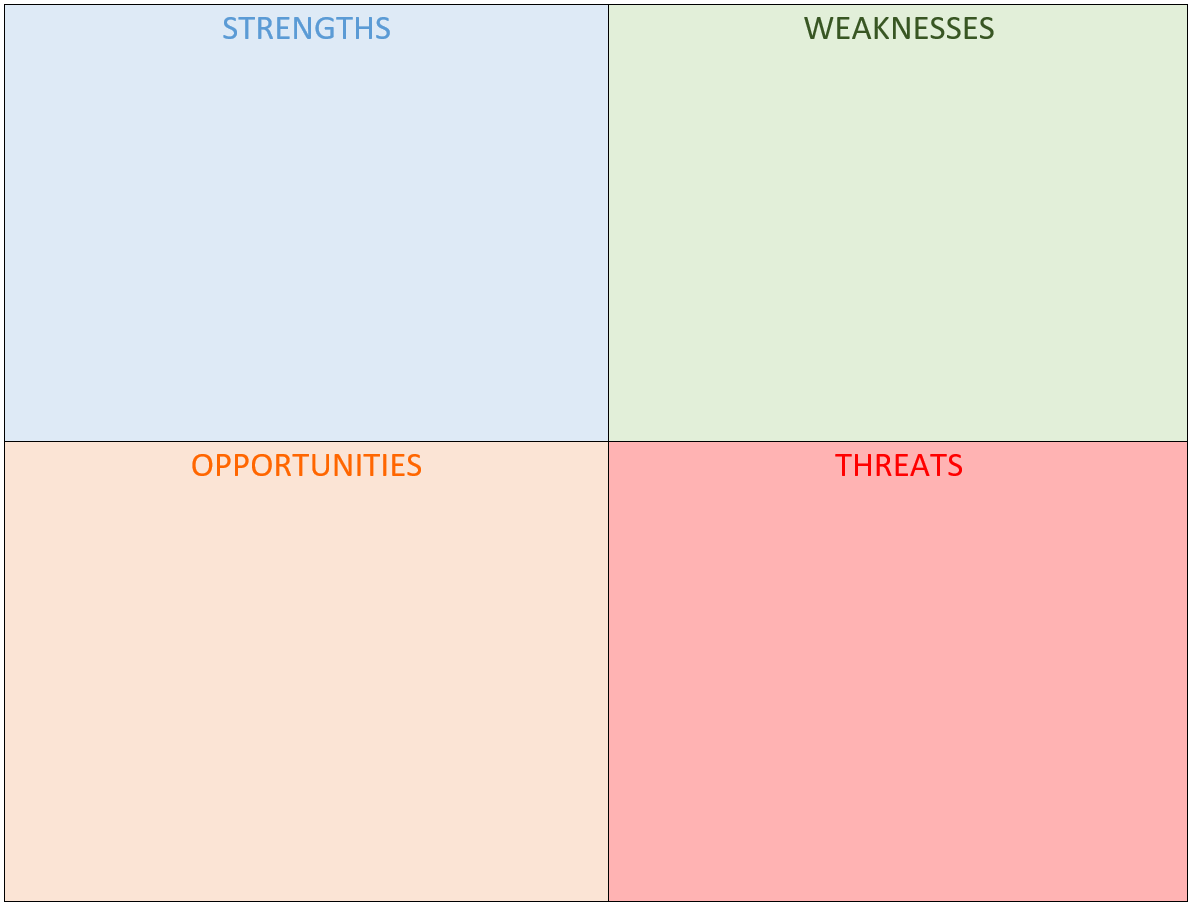
Your list of strengths should focus on your current resources and abilities. It should relate to things that you do or that your company does well. These might be your or your company's accomplishments—both great and small—and the assets that you or your company have. Your strengths give you your greatest edge; they are the resources that propel you forward and that you can continue to develop as you progress.
When you draw up your first SWOT analysis, you may find yourself at a loss. Don't worry—it's difficult for most people to come up with an objective list of strengths and weaknesses on the spot. For your convenience, we've included a list of questions you can ask yourself to get started.
These questions should help you identify a few of your strengths. Remember, while our example questions mostly relate to business strengths, they can also apply to personal strengths. Go ahead and boast as much as you can.
- What sets your company apart from others?
- What do you have that other companies don't?
- What are you most proud of about your company?
- What makes clients come back to you?
- What does your company do well?
- What assets do you have access to?
- What qualities does your company have that other companies try to emulate?
- What has always been easy for your company?
Listing your weaknesses might be a little more uncomfortable than detailing your strengths, but trust us—doing so will help you in the long run. Understanding the obstacles in your path and the elements of your business or skills you may need to improve is just as important as appreciating your strengths. Once you're aware of your weaknesses, you can start working on them and building your next steps around them.
Your list of weaknesses should pertain to any current problems and challenges. Check out the list of questions below—it should give you an idea of where to start. Again, if you'd rather focus on your personal or career growth, feel free to alter these questions to suit your needs.
- What makes your company blend in with its competition?
- What do other companies have that you don't?
- What are the most common criticisms that you receive from clients?
- Why have certain clients not returned to you?
- What does your company need to improve upon?
- What kind of feedback do you receive from your employees?
- What might your competition consider to be a weakness?
- What has always been difficult for your company?
- What are you unwilling to do or change?
Opportunities
Think about the opportunities available to you as potential future strengths. Your opportunities are the assets, resources, and events that could be beneficial to you in some way in the future. You may need to change some of your current approaches or adapt in other ways to capitalize on these opportunities, and that is not necessarily a bad thing.
Here are some questions you can ask yourself to identify your potential opportunities:
- What is happening in the current market that you could capitalize upon?
- What changes have you been making that have returned positive results?
- What is working for other companies?
- How could you introduce new technology to make your processes more efficient?
- What costs can you cut?
- Could you access new sectors or demographic groups?
- How can you improve or modernize your marketing techniques?
- How can you remove existing obstacles?
Threats
Just as your opportunities are based on potential, so are your threats; these are the possible obstacles or issues that are not yet directly affecting your progress. But this doesn't mean that you shouldn't start thinking about them! Being aware of the challenges that you may encounter will help you either plan around them or confront them with solutions. Try to come up with several future events that may realistically hinder the momentum you build from engaging with your strengths and opportunities.
To get started, take a peek at our list of questions:
- What obstacles might your weaknesses create?
- Do changing market trends negatively affect your competitive edge?
- What might stand in the way of the changes you make to accommodate your strengths and opportunities?
- Do you have a lot of debt?
- Could your competition exploit your weaknesses?
How did you do? Do you feel like you've listed everything? Or do you think you're missing something? Below, we've drafted examples of a business and a personal SWOT analysis to provide you with some perspective on what a completed one might look like.
An Example of a Personal SWOT Analysis
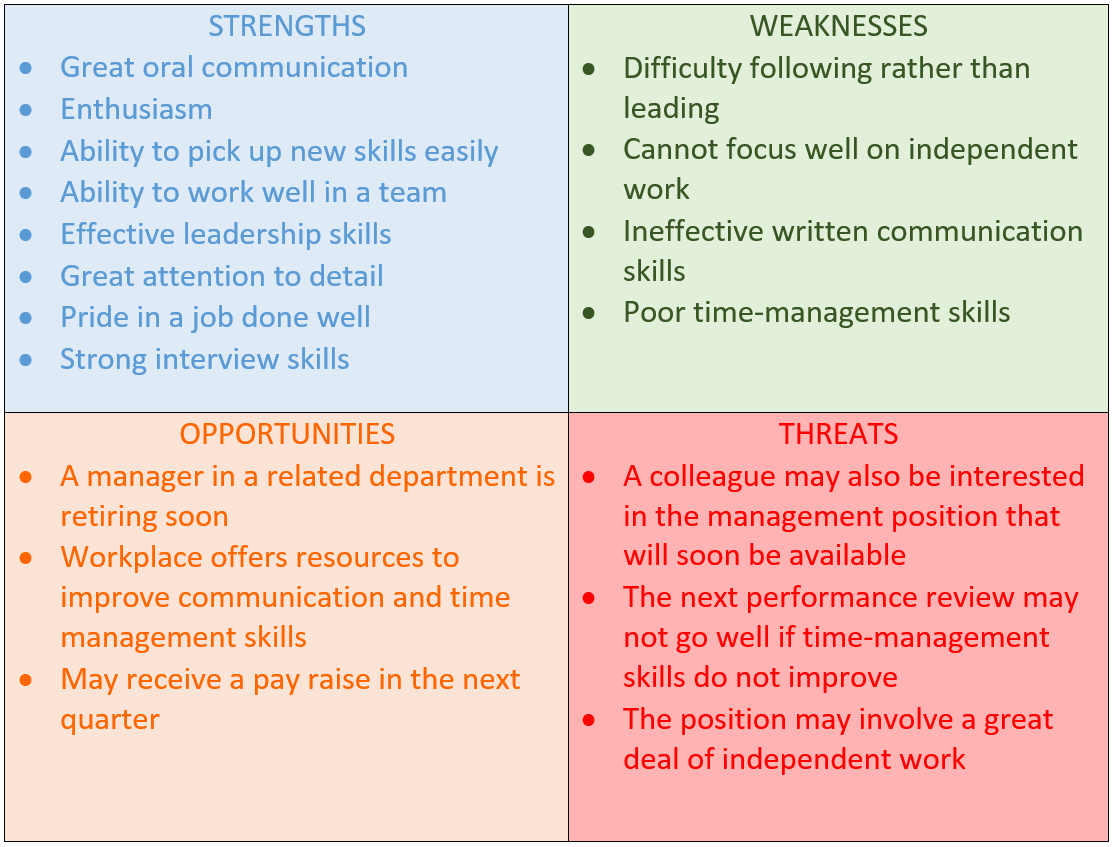
An Example of a Business SWOT Analysis
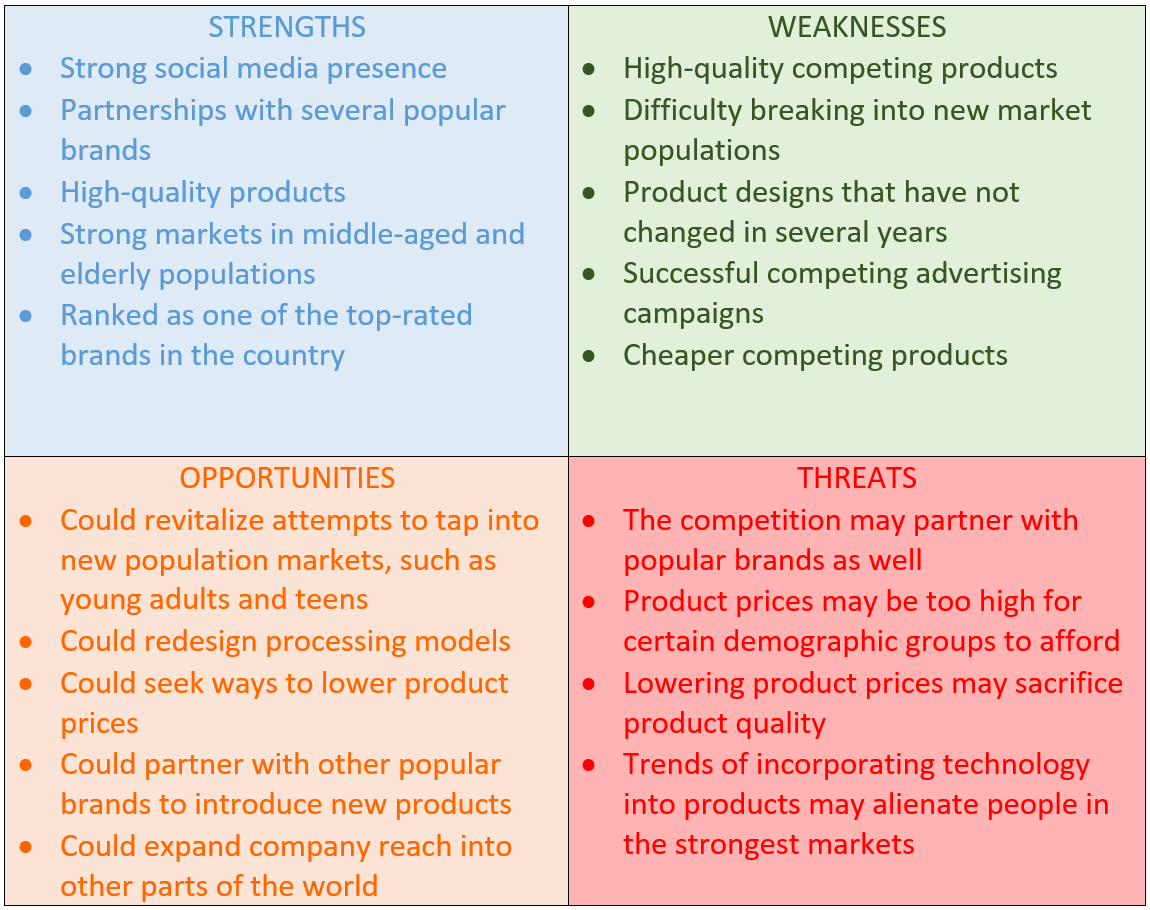
Final Words
The humble but effective SWOT analysis will produce a detailed map of your current environment—its hills and valleys alike. Knowing how to write a SWOT analysis will provide you with the vantage point you need to choose a direction and blaze a trail toward your goals. SWOT analyses may not be crystal balls, but they are something like compasses. Use them wisely, and you will never be lost.
Image source: cookelma/unspla sh.com
Make a Strong Start. Connect with a Professional Editor.
Hire one of our expert editors , or get a free sample, about the author.

Scribendi's in-house editors work with writers from all over the globe to perfect their writing. They know that no piece of writing is complete without a professional edit, and they love to see a good piece of writing turn into a great one after the editing process. Scribendi's in-house editors are unrivaled in both experience and education, having collectively edited millions of words and obtained nearly 20 degrees collectively. They love consuming caffeinated beverages, reading books of various genres, and relaxing in quiet, dimly lit spaces.
Have You Read?
"The Complete Beginner's Guide to Academic Writing"
Related Posts

How to Write a Business Plan

How to Write a Letter of Recommendation

Traditional Publishing versus Self-Publishing: What's the Difference?
Upload your file(s) so we can calculate your word count, or enter your word count manually.
We will also recommend a service based on the file(s) you upload.
English is not my first language. I need English editing and proofreading so that I sound like a native speaker.
I need to have my journal article, dissertation, or term paper edited and proofread, or I need help with an admissions essay or proposal.
I have a novel, manuscript, play, or ebook. I need editing, copy editing, proofreading, a critique of my work, or a query package.
I need editing and proofreading for my white papers, reports, manuals, press releases, marketing materials, and other business documents.
I need to have my essay, project, assignment, or term paper edited and proofread.
I want to sound professional and to get hired. I have a resume, letter, email, or personal document that I need to have edited and proofread.
Prices include your personal % discount.
Prices include % sales tax ( ).

An official website of the United States government
The .gov means it's official. Federal government websites often end in .gov or .mil. Before sharing sensitive information, make sure you're on a federal government site.
The site is secure. The https:// ensures that you are connecting to the official website and that any information you provide is encrypted and transmitted securely.
- Publications
- Account settings
- Browse Titles
NCBI Bookshelf. A service of the National Library of Medicine, National Institutes of Health.
StatPearls [Internet]. Treasure Island (FL): StatPearls Publishing; 2024 Jan-.

StatPearls [Internet].
Swot analysis.
Dac Teoli ; Terrence Sanvictores ; Jason An .
Affiliations
Last Update: September 4, 2023 .
- Definition/Introduction
SWOT Analysis (short for strengths, weaknesses, opportunities, threats) is a business strategy tool to assess how an organization compares to its competition. The strategy is historically credited to Albert Humphrey in the 1960s, but this attribution remains debatable. There is no universally-accepted creator. Also known as the SWOT Matrix, it has achieved recognition as useful in differentiating and establishing a niche within the broader market. Beyond the business world, SWOT Analysis can also be applied to the individual-level to assess a person's situation versus their competition further. There are both internal and external considerations build into the tool. "Strengths" and "weaknesses" are internally-related. The former representing a facet of an organization/entity which lends it an advantage over the competition. The latter being characteristic of that same entity, which leads to a relative disadvantage against the competition. Regarding externally-related, "opportunities" are realities in the greater environment that can be exploited to benefit the entity. While on the other hand, "threats" are realities in the greater environment, which might lead to problems for the entity.
The concept of strategic fit, a ubiquitous objective sought by all organizations, can be explained as to how well the internally-related factors fit with the externally-related factors. [1]
- Issues of Concern
While the SWOT analysis is widely known to facilitate the formation of organizational or personal strategy by assessing internal and external elements, it also has its criticisms. Some critics feel that the tool proves to be too superficial and formulaic, consequently hindering performance as outputs might be misunderstood or misused. This latter point is especially pertinent when SWOT analysis is attempted without real critical reflection by a collective group. Having only a few individuals perform the assessment increases the risk of misrepresentation of the SWOT inputs, leading to erroneous outputs. Also, organizations can anchor on one facet of the analysis, losing sight of the other critical elements of the matrix. Lastly, the SWOT captures the internal and external aspects of a single time-point. In reality, the environment is rapidly evolving. [2] [3]
- Clinical Significance
Given that the SWOT Analysis looks at factors both inside and outside an entity, it is also occasionally labeled as an Internal-External Analysis. In consideration of the broad nature of the tool, it has both organizational and individual utility. Although borne out of the business world, it does have clinical applicability such as at the organizational level.
At the level of hospital or clinical offices, implementation of SWOT is achievable by asking questions such as the following:
- What are the organization's advantages?
- What can you do better than others?
- What unique or lowest-cost services can you provide patients?
- What do patients in your market see as your organization's strength?
Weaknesses:
- Upon what factors could the organization improve?
- What are patients in your market likely to see as your organization's weakness?
- What lack of services loses your organization patients?
Opportunities:
- What good opportunities are available to your organization?
- What are the new and exciting trends your organization can try?
- What new changes to governmental regulation/policy can benefit your organization?
- What problems does your organization face?
- Of what are your organization's competitors taking advantage?
- Do evolving technologies and new services threatening your organization's position in the minds of patients?
- Does your facility have cash-flow problems?
- Could any of your weaknesses threaten quality patient care? [4] [5] [6]
- Review Questions
- Access free multiple choice questions on this topic.
- Comment on this article.
Disclosure: Dac Teoli declares no relevant financial relationships with ineligible companies.
Disclosure: Terrence Sanvictores declares no relevant financial relationships with ineligible companies.
Disclosure: Jason An declares no relevant financial relationships with ineligible companies.
This book is distributed under the terms of the Creative Commons Attribution-NonCommercial-NoDerivatives 4.0 International (CC BY-NC-ND 4.0) ( http://creativecommons.org/licenses/by-nc-nd/4.0/ ), which permits others to distribute the work, provided that the article is not altered or used commercially. You are not required to obtain permission to distribute this article, provided that you credit the author and journal.
- Cite this Page Teoli D, Sanvictores T, An J. SWOT Analysis. [Updated 2023 Sep 4]. In: StatPearls [Internet]. Treasure Island (FL): StatPearls Publishing; 2024 Jan-.
In this Page
Bulk download.
- Bulk download StatPearls data from FTP
Related information
- PMC PubMed Central citations
- PubMed Links to PubMed
Similar articles in PubMed
- Analysis of Strengths, Weaknesses, Opportunities, and Threats as a Tool for Translating Evidence into Individualized Medical Strategies (I-SWOT). [Aorta (Stamford). 2015] Analysis of Strengths, Weaknesses, Opportunities, and Threats as a Tool for Translating Evidence into Individualized Medical Strategies (I-SWOT). von Kodolitsch Y, Bernhardt AM, Robinson PN, Kölbel T, Reichenspurner H, Debus S, Detter C. Aorta (Stamford). 2015 Jun; 3(3):98-107. Epub 2015 Jun 1.
- Strengths, Weaknesses, Opportunities, and Threats (SWOT) Analysis of Hemodialysis Electronic Health Record Implementation. [Cureus. 2024] Strengths, Weaknesses, Opportunities, and Threats (SWOT) Analysis of Hemodialysis Electronic Health Record Implementation. Bennis B, El Bardai G, Chouhani BA, Kabbali N, Sqalli T. Cureus. 2024 Feb; 16(2):e54675. Epub 2024 Feb 22.
- Ranking the strategies for Indian medical tourism sector through the integration of SWOT analysis and TOPSIS method. [Int J Health Care Qual Assur. ...] Ranking the strategies for Indian medical tourism sector through the integration of SWOT analysis and TOPSIS method. Ajmera P. Int J Health Care Qual Assur. 2017 Oct 9; 30(8):668-679.
- Review Universal Health Coverage in Iran: A Review of Strengths, Weaknesses, Opportunities, and Threats. [Med J Islam Repub Iran. 2023] Review Universal Health Coverage in Iran: A Review of Strengths, Weaknesses, Opportunities, and Threats. Askarzade E, Nabizade Z, Goharinezhad S, Mostaghim S. Med J Islam Repub Iran. 2023; 37:6. Epub 2023 Feb 13.
- Review A SWOT analysis of contemporary gaps and a possible diagnostic tool for environmental health in an upper-middle income country: a case study of South Africa. [Int J Environ Health Res. 2022] Review A SWOT analysis of contemporary gaps and a possible diagnostic tool for environmental health in an upper-middle income country: a case study of South Africa. Mbazima SJ, Mbonane TP, Masekameni MD. Int J Environ Health Res. 2022 Dec; 32(12):2820-2842. Epub 2021 Oct 31.
Recent Activity
- SWOT Analysis - StatPearls SWOT Analysis - StatPearls
Your browsing activity is empty.
Activity recording is turned off.
Turn recording back on
Connect with NLM
National Library of Medicine 8600 Rockville Pike Bethesda, MD 20894
Web Policies FOIA HHS Vulnerability Disclosure
Help Accessibility Careers
- Skip to primary navigation
- Skip to main content
- Skip to primary sidebar
PESTLE Analysis
The Latest and Best Analysis Online
Step-by-Step Guide to Compose a Successful SWOT Analysis Paper
Last Updated: Dec 26, 2022 by PESTLEanalysis Contributor Filed Under: SWOT Analysis
Many businesses like to use SWOT analysis in order to look at the external and internal strengths of the company. They can be changed, but often it does require work, and that’s what a SWOT analysis provides. It’s a big part of the overall business planning process, and it will save a person a lot of time later on.
So how does one create a SWOT analysis paper? This article will discuss how it’s done, and what one needs to have in order to create the best and most in-depth SWOT analysis paper possible.
Break It Down
First, the analysis paper should be broken down into three parts that will help you out, and they are as follows:
- The company itself;
- The analysis;
- The strategies to convert weaknesses to strengths;
- The ability to handle opportunities and neutralizing threats;
- Any other growth strategies.
This is what the paper should be about, and by having all of this here, you’ll be on your way to starting a successful paper.
Talk about the Company
In the paper, you have to begin with just what the company is. An introduction will tell your reader about it and what its product is.
Some things to include are the following:
- Who they are, the name of the company, the place they originate, and maybe a date of origin;
- The product that they have.
This is a short section, but it’s important to have as an introductory section.
Analyze the Elements
Now, let’s go over each of the elements you need to focus on. These are usually the findings from your SWOT analysis.
The first is strengths. What is the company doing right now? What capabilities do they shine in? The resources both internally and externally such as talking to customers or even looking at the company’s assets is a huge part. This is what they give to provide that advantage over others. Usually seeing the customer satisfaction, walking in, or even looking at logos work as well.
Weaknesses are next, and they’re what the company isn’t doing so good with. These can be factors that are stopping them from getting more out of their advantages as well as do not let the company move forward and get more clients. Thus, the marketing plan and budget are also good to look at.
Then, there are opportunities. These are the external factors that the business can benefit from, be it the customer repute, the environment, or even growth of various facets that the company should take advantages of. Analyze the window, and even the timing of it. Various events can also affect the opportunities that the business might face.
Finally, there are threats. These are the external factors that could potentially harm the business. These are competitors using various ads and partnerships, your own media expense, any new technology that could be released, the change of supply and demand, the shifting attitudes that others might have, any other external situations that could be there, and anything that’s beyond the control of the business owner that’s putting the business at risks.
Put all of these down in various sections in the paper, giving an analysis of the overall look of the business, and what is going on there.
Convert the Weaknesses
Next, you need to convert the weaknesses to strengths. This can be looking at the listed weaknesses and looking at new strategies to help one succeed.
This can be anything from a better social media presence, such as a Facebook page or an Instagram account for the business, which will help convert more people depending on the business being analyzed.
At this point, look at the other programs that can be added. Maybe the business lacks a loyalty program, so one can create it. Or maybe, it needs to be relocated. These are all weaknesses that could come forward, thus, better have a look at what they are and find some low-cost ways to fix them.
Analyze Growth Strategies and Opportunities That Might Arise
Finally, now that the weakness to strength conversions have been seen, it’s time to create a growth strategy. This means creating a plan to increase the business, using the opportunities that show up. This can include a bigger social media presence, more events, new locations and business hours if needed, any new factors that can show up more discounts and sales.
To look at the growth is to also look at the threats. See the threats there, and work to reduce them, or completely neutralize. This can be reducing the ad budget or moving towards the quality ads, and from there, the business can grow, using whatever shows up that reduce any outside elements that are affecting the overall business repute.
By integrating all these points into the paper, one can create a professional essay from scratch that will showcase a great look at the business. There are four elements that need to be looked at, and if they’re analyzed completely and in an in-depth manner, it can provide a picture for the business to look at in order to help them better understand the path they must take next as well as different opportunities that might arise as well.
Your Full Guide on How to Write a SWOT Analysis

SWOT analysis is one of those tools that you'll come across in any field. For example, it's used to define a product's competitive advantage, create a strategic plan for a business, and gain insights into consumer behavior.
But it's not just businesses that benefit from this technique. Personal SWOT analysis helps people plan their careers in the most optimal way possible, too.
As versatile as it is, SWOT analysis is not at all complicated. That's why its adoption rate is through the roof. And that's why you should learn how to take advantage of it, whether for an assignment or not.
To help you out with that, let's rely on our rich writing services experience and use it to break down in detail:
- What a SWOT analysis is;
- How it's applied in business strategies and marketing efforts;
- How to use the SWOT framework for any task;
- 4 real-world SWOT analysis examples.
What Is SWOT Analysis, Exactly?
Any SWOT analysis template contains four sections, presented in a two-by-two matrix:

- Strengths – your inherent qualities, resources, or skills that set you apart from the rest;
- Weaknesses – whatever is or may be stopping you or the business from performing well;
- Opportunities – external factors that you can use to your advantage to become more competitive;
- Threats – external factors that may harm your performance in the short or long run.
Internal and External Factors in SWOT Analysis
Each section represents a list of factors. These sections can be grouped into two broader categories: internal and external factors.
Internal factors – Strengths and Weaknesses in the first row – are inherent to you or the company. However, you can also do something about them if need be. Think of your skills as a professional if you're working on a personal SWOT analysis, for example.
External factors – Opportunities and Threats in the second row – aren't under your personal or the company's control. But they have an impact on you or the business, nonetheless. Once-in-a-lifetime pandemics, inflation, or industry trends are good examples here.
Positive vs Negative Factors
Another way to think about the SWOT matrix is by juxtaposing negative and positive factors :
- Strengths and Opportunities can help you or the company achieve your goal or succeed at a project. So, they represent positive factors.
- Weaknesses and Threats can negatively impact your progress and have to be mitigated. They're negative factors.
Why is SWOT Analysis Important?
Now that the question ‘What is a SWOT Analysis?’ is answered, you must have several others on your mind. So let's answer them one by one.
Who Should Do a SWOT Analysis?
Businesses of all sizes and in all industries can benefit from SWOT analyses. So, whether you're a prospective entrepreneur, a small business owner, or a C-level executive, this technique will be a useful arrow in your quiver.
You can also benefit from conducting a personal SWOT analysis. It would be best if you did it when looking for a job or facing a major life decision.
Why Should You Do a SWOT Analysis?
At its core, SWOT analysis is a strategic planning technique. It's meant to help you organize all the factors. That, in turn, enables you to gain key insights into where you stand and how you can move from point A to point B.
How does it help you in strategic planning, exactly? The SWOT matrix shows you:
- Which strengths you should maximize and emphasize;
- Which weaknesses you should minimize and keep at bay;
- Which opportunities you can take advantage of;
- Which threats you should look out for and counter.
All of this leads to one outcome: better, more informed decision-making. Plus, SWOT analysis is notorious for challenging your assumptions as long as everyone involved is straightforward and honest in their answers.
What Can SWOT Framework Be Used For?
Now, let's talk about real-life practical applications of this technique. Here are three SWOT analysis examples:
- Choosing the business model for a new enterprise;
- Creating a break-even analysis and a business plan;
- Analyzing the company's quarterly and annual performance.
At a personal level, you can also conduct your own SWOT analysis to:
- Increase your chances of landing a job;
- Position yourself for getting a promotion;
- Understand what needs to change in your life in general.
Stay on Top of Your SWOT Analysis Homework!
Turn to our professional writers for your upcoming assignment.
How to Conduct a SWOT Analysis in 8 Steps
SWOT analysis isn't complicated to conduct, and that's why they are so popular. Yet, it might be a wrong first impression.
A good SWOT analysis can take hours and should involve multiple people in a brainstorming session. It should also be as objective as possible – which can be harder to achieve than it seems.

So, how do you use a SWOT analysis – and get a quality result for your strategic decision-making process? Here's your step-by-step SWOT analysis example that you can use as a guide. If you need a custom writing -address to professionals.
1. Determine Your Goal
Starting brainstorming without a goal means getting into the SWOT analysis blind. And your SWOT matrix will be useless – or misleading – in the long run.
For example, depending on your goal, the same factor can be a key strength or an irrelevant note. For example, if you aim to reach the 18-25 demographic in your marketing campaign, your active presence on TikTok will be a great asset. But if you need to find a way to attract more quality candidates in the hiring process, the TikTok presence will only help you a little.
So, zero in on what you want to achieve with this SWOT analysis. This can be a decision you or the company have to make – for example, whether to launch a certain product line. Your goal can also be to solve a certain problem or to create/reassess your strategy.
2. Do Your Research
Your research wouldn't be complete if you googled ‘What is a SWOT analysis?’ You'll need a lot of data during your brainstorming session. If you have it, you'll avoid guessing your company's or your own strengths or external threats related to your goal.
What Data to Look For
Your research should consist of two parts:
- Internal research . You'll need every piece of information on your or the company's performance to pinpoint the internal factors in SWOT analysis. That can include financial, sales, marketing, and other reports with key metrics.
- External research . Gather the data on your competitors, the market, the company's position and market share, and the industry as a whole. This data will be the basis for assessing your opportunities and threats.
There's one footnote, though. Depending on the goal, you'll need different data sets. So, focus on relevant data.
3. Pinpoint Your or Your Organization's Strengths
Now, it's time for the brainstorming session. If you're doing a SWOT analysis for a business, go with it: bring the right people to the table, virtual or not. It'll help you get a more objective, realistic, and complete matrix.
Start with the internal factors, namely your internal strengths: they're always easier to home in on.
Need a SWOT analysis example of a company's strengths? Here are five of them:
- Outstanding customer service with a high satisfaction rate;
- Strong financial performance;
- The first-mover advantage;
- Positive brand attributes;
- Strong technical expertise in the field.
5 Questions to Ask
Here are five questions to kick off your brainstorming and help you discover your company's strengths – or your own:
- What do you or the company do well?
- What are your strongest assets?
- Is there something only you or the company do?
- What is your competitive edge?
- What do customers appreciate about the company?
4. Zero in on Your or Your Company's Weaknesses
Now, it's time to move on to a more difficult part of assessing your internal factors: your weaknesses. Take a hard look at your or the business's performance and define what could be going better. Don't try to embellish the truth here!
Keep in mind: there are some weaknesses that you can eliminate and some others that you can only mitigate.
Looking for weaknesses SWOT analysis examples for students who run their businesses? Here are five of them:
- Poor brand recognition among the target audience;
- Suboptimal employee productivity;
- Limited resources, human or otherwise;
- Lack of intellectual property for key technologies;
- Long delivery times.
To explore your personal or business weaknesses, ask the following five questions:
- What do your competitors beat you at?
- What do customers complain about?
- What is holding back your or the company's success?
- What resources do you or the company lack?
- What are the gaps in your internal business processes?
5. Identify External Opportunities
Before you can exploit opportunities, you need to identify them in your SWOT analysis – and determine which ones are worth using, too.
For that, you'll need to turn to the external environment research you've done. Then, look at that data and pinpoint which trends or events you could take advantage of.
Need a SWOT analysis example or two here? Take a look at these three business opportunities:
- New markets emerging within the industry;
- New advertising channels rising to prominence;
- Particular customer needs that remain underserved.
4 Questions to Ask
If you don't know how to start zeroing in on opportunities, start with these four questions:
- Are there ways to gain useful resources you don't have or have little of?
- Are there any technological advancements that can help you mitigate your weaknesses?
- Are there any new or overlooked opportunities that you can exploit?
- How can the current economy or market trends be of use to you?
6. Home in on Potential Threats
Time to move on to the final part of a standard SWOT analysis: threats. These external trends and events can get in your way – or already are.
If you're working on a personal SWOT analysis, threats can include:
- High competition for the job you're after;
- Potential layoffs due to a financial crisis.
If you're conducting one for a large company or a small business, negative external factors can include:
- New emerging competitors, direct or indirect;
- New regulations that can entail considerable additional costs for the business;
- Unfavorable investment climate.
3 Questions to Ask
If you need a push in the right direction, here are three questions to help you zero in on the threats:
- Who are your competitors, and what is their market position?
- What is the state of the economy, industry, and market? Are they in decline?
- Are there any new regulations that can harm the business?
7. Review Your SWOT Analysis Matrix
Having a good SWOT analysis right after brainstorming is impossible. You need to review every factor you've written down and edit the list. Leave only the elements that truly matter – and make them more specific if required.
3 Things to Pay Attention to
There are some common caveats that you can overlook if you need to be more careful during this step. Here are three of them to avoid:
- Factors that aren't specific enough – clarify or cross them out;
- Factors that aren't evidence-based – find proof or get rid of them;
- Factors that are over- or underestimated – have a fresh pair of eyes to look at the list.
8. Decide on the Solution
Once you've finished filling out and editing your SWOT analysis template, your work is only beginning. Now, you need to take your SWOT matrix and use your findings to find the solution to your key issue.
4 Questions to Pose
Here are four questions to guide you in your solution-seeking:
- How can you maximize your strengths? Which ones should be the top priority to boost?
- How can you mitigate or eliminate your weaknesses? Which ones should be taken care of first?
- Which opportunities should you take advantage of? Which ones will pay off the most?
- Which threats can do the most harm? How can you limit their impact?
4 SWOT Analysis Examples for Students
Need something more than just a SWOT analysis template? Let's see how this tool can be applied to practice with these four real-world SWOT analysis examples for students.
But if these sample SWOT analysis still don't help you, don't panic just yet. You can always order an essay online and let professionals worry about it. And no, it won't cost you a small fortune!
Amazon and Tesla Analysis
Apple and personal swot analysis, are you drowning in schoolwork.
Students that need a little additional encouragement with their tasks can benefit from our top essay writing service
Related Articles
%20(1).webp)

SWOT Analysis
All business students are assigned to conduct SWOT analysis, usually at the earlier stages of their studies. This page focuses on the application of SWOT analysis in a business context as a part of academic assignments . This is a comprehensive SWOT resource and it contains an explanation of SWOT theory, an illustration of how to do a SWOT analysis and links to examples of SWOT analysis of major multinational brands. Moreover, SWOT analysis template further below can be used to generate SWOT tables of top multinational companies along a range of industries.
SWOT Analysis: Theory
SWOT is a strategic analytical tool for assessing strengths and weaknesses of a business, analyzing opportunities available to the business, as well as, threats faced by the business. SWOT analysis can be used at organizational and personal levels.
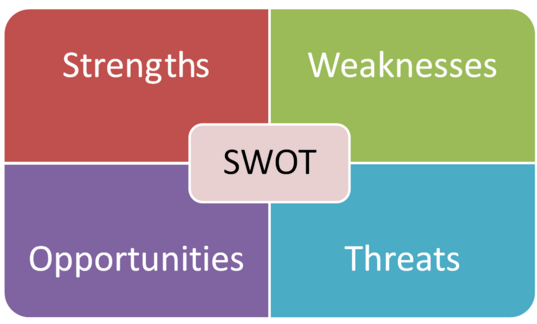
As it is illustrated below, strengths and weaknesses are internal, i.e. businesses are able to influence and to manipulate with their strengths and weaknesses. Opportunities and threats, on the other hand, are external. It means businesses can only react to opportunities and threats and they do not have any means to influence opportunities and threats.
SWOT analysis has important practical implications. Specifically, with findings of SWOT analysis in their hands, the senior level management identify and built upon their strengths, discover new opportunities and work upon eliminating or minimising threats to the business. Accordingly, SWOT can be a powerful aid for senior level management to develop appropriate strategy for the business.
As a strategic analytical tool, SWOT analysis has some weaknesses as well. Specifically, the application of this tool may encourage users to focus on quantity of factors, instead of focusing on a few, but the most powerful factors having the biggest impact on the business. In other words, SWOT analysis lacks guidance and provision in terms of differences in importance between factors. As a result weak strengths may appear to balance strong weaknesses.
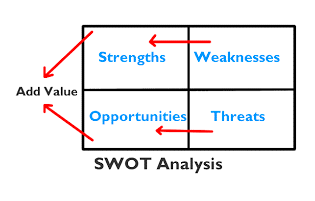
The majority of sources explaining SWOT analysis assume that their audience is businesses aiming to improve their operational efficiency. This SWOT analysis resource is different. It explains SWOT analysis assuming that you a business student and you have been assigned to conduct SWOT analysis as a part of your assignment.
How to do SWOT Analysis
You can conduct a SWOT analysis with the following four steps:
Step 1: Selecting a company
If your assignment requires conducting a SWOT analysis, you are either given a case study company by your educational institution or you are free to analyze a company of your own choice. In the first scenario, you have no option but to conduct a SWOT analysis of the company named in your assignment instructions. However, the majority of educational institutions provide students the flexibility to conduct SWOT analysis of a company of their own choice.
Students are often tempted to conduct SWOT analysis of their employer. Choosing your employer as a case study can be a good strategy if you have an access to detailed relevant information. Please note that only descriptive information would not suffice and you will have to justify your arguments by referring to relevant quantitative data. Therefore, if you are not able to find relevant quantitative data about your employer, your best choice could be to conduct SWOT analysis of a multinational enterprise. This is due to the availability of data about the majority multinational enterprises. This portal offers up-to-date sample SWOT analyses of the most famous multinational enterprises as part of company reports .
Step 2: Finding information
If you are conducting a SWOT analysis of a small or medium sized organization such as your employer, family business or a company you are related to in some ways, approaching the company directly may prove to be an efficient strategy to obtain required information. You may try to secure a meeting with a senior level manager and explain practical implications of your SWOT analysis for the business. In other words, you may be able to convince a senior manager that results of your SWOT analysis may provide an important insight into the business and managers can act upon this knowledge to increase the efficiency of the business at various fronts.
Alternatively, if you are conducting SWOT analysis of a multinational enterprise, company annual report is usually the most comprehensive source of the relevant information. Note that annual reports highlight information about strengths of the business within the first few pages and you cannot find information about weaknesses of a company in its annual report for obvious reasons.
Information about Strengths in SWOT Analysis
Information about strengths of the company is easiest to find in your SWOT analysis. Strengths are competitive advantages of the business that made it successful in the first place. In case of small or medium sized organizations, the manager you are interviewing will be happy to discuss the strengths of the business.
In case of multinational companies, on the other hand, the first few pages of annual reports boast about competitive advantages of the business by referring to specific figures and charts. Using some of these charts in your assignment and properly referencing the source is going to increase the quality of your work.
You can determine strengths of businesses in answers to the following questions:
- What advantages does the company have?
- What does the company better than its competitors?
- What unique or low-cost resources are available to the company that are not available to its rivals?
- What Unique Selling Propositions (UPS) are associated with the company?
The following table illustrates the major strengths possessed by businesses and tips about how to discuss these strengths in your swot analysis:
Information about Weaknesses in SWOT Analysis
It may not be easy to find information about weaknesses of small and medium sized businesses. The manager you are interviewing may not want to discuss weaknesses of their business either intentionally, or they may not be aware of weaknesses. It is important for you to motivate your interviewee to discuss weaknesses of their company by asking relevant questions in a polite way.
It is easier with multinational organizations. An extensive online research can reveal relevant information about weaknesses associated with the company you are analyzing.The majority of big corporations have been involved in some kind of scandals during the past two years and you can discuss the damage of these scandals to the brand image as noteworthy weakness of the company.
For example, suppose you have chosen Coca Cola Company for your SWOT analysis assignment. If you google the term ‘Coca Cola scandal’, search results on the top relate to a scandal where the company funded obesity research that downplayed the negative health implications of Coca Cola products. Negative implications of this incident on Coca Cola brand image is brand’s weakness you can discuss in you SWOT analysis.
All arguments and numbers need to be referenced using referencing style required by your educational institution in an appropriate manner. Preference has to be given to online journals and magazines over online discussion forums and personal blogs.
Answers to the following questions can help to identify weaknesses of your case study company:
- What aspects of the business could the company improve?
- What should the company avoid?
- What factors are causing the company to lose sales?
- What aspects of products/services are customers are likely to see as weaknesses?
Major weaknesses of businesses and brief tips about discussing them in your assignment are illustrated in the following table:
Information about Opportunities in SWOT Analysis
Information about opportunities available to the business can be derived from its weaknesses in a way that businesses often have an opportunity to turn their weaknesses into strengths. At the same time, it is important that your SWOT analysis also identifies a set of opportunities that are not related to weaknesses. If you can’t think of any company-specific opportunities, you can discuss business opportunities that can be explored by any business in general, such as new product development, international market expansion and increasing the level of effectiveness of social media marketing. Interesting trends in the industry can also be opportunities for the business.
Opportunities can be identified through answering the following questions:
- What are interesting trends in the market that can be profitably explored by the company?
- What are the demographic and social changes that present new opportunities in the industry?
- Are there any government policies and regulations that can help the industry?
- Are there any opportunities for the company related to technological developments?
The following table illustrates the major opportunities available for businesses and tips about how to discuss these opportunities in your SWOT analysis:
Information about Threats in SWOT Analysis
Threats faced by the business can be classified into two categories. Firstly, there are company-specific threats that stem from company-specific factors such as the threat of losing market share due to ineffective cost structure or the threat of negative media coverage and damage to the brand image due to neglecting the importance of corporate social responsibility. Secondly, there are threats to the industry or to the economy on the whole, such as a threat of introducing tariffs to a certain range of products or the threat of a global economic and financial crisis. You will need to find information about threats belonging to both categories with more emphasis on the threats from the first category, i.e. company-specific threats.
You can identify the main threats to the business through answering the following questions:
- What are the main obstacles faced by the company?
- What are the latest developments in competitor Unique Selling Propositions?
- Does the company have substantial amount of bad debts or cash-flow problems?
- Was the company involved in any scandal recently?
Main threat facing the majority of businesses and brief tips about discussing them in your SWOT analysis are illustrated in the following table:
Step 3: Writing
You can structure your writing of SWOT analysis in the following way:
Firstly, you will need to discuss the company profile, its strategy and the most recent changes that have taken place in the company prior to presenting your SWOT analysis. The length of such a discussion depends on your assignment instructions and the total word count for your assignment.
Secondly, develop a SWOT Analysis Matrix for your chosen company. You can develop a table containing four sections headed strengths, weaknesses, opportunities and threats. Major strengths, weaknesses, opportunities and threats of your chosen company can be presented in bullet points under respective boxes. These should be precise and verifiable statements.
Using steps 1 and 2 above, you should have long list of factors related to strengths, weaknesses, opportunities and threats for the business. Now it is time to prioritize factors to be included in your SWOT analysis by focusing on the most significant factors. The numbers of factors that should be discussed under each category depends on the total word-count for your assignment.
Thirdly, you have to discuss bullet points in your SWOT table. Your analysis needs to contain statistical data and ideally graphs and tables as well. Do not forget to reference sources, using referencing system required by your university. Moreover, you can discuss how to address weaknesses and threats identified as a result of your SWOT analysis and get additional marks for your work.
SWOT Analysis Example
This portal contains example SWOT analysis of the following companies:

SWOT is an acronym for strengths, weaknesses, opportunities and threats related to organizations. The following table illustrates SWOT analysis:
SWOT Analysis Template
Please choose an industry and a company below to generate a SWOT table containing bullet points of strengths, weaknesses, opportunities and threats of your chosen company. In order to complete the SWOT analysis you will need to expand the bullet points into a couple of paragraphs with discussions and references from reliable sources to support your arguments.
- Search Search Please fill out this field.
What Is SWOT Analysis?
Understanding swot analysis, how to do a swot analysis, the bottom line.
- Fundamental Analysis
SWOT Analysis: How To With Table and Example
These frameworks are essential to fundamentally analyzing companies
:max_bytes(150000):strip_icc():format(webp)/wk_headshot_aug_2018_02__william_kenton-5bfc261446e0fb005118afc9.jpg)
Ariel Courage is an experienced editor, researcher, and former fact-checker. She has performed editing and fact-checking work for several leading finance publications, including The Motley Fool and Passport to Wall Street.
:max_bytes(150000):strip_icc():format(webp)/ArielCourage-50e270c152b046738d83fb7355117d67.jpg)
SWOT (strengths, weaknesses, opportunities, and threats) analysis is a framework used to evaluate a company's competitive position and to develop strategic planning. SWOT analysis assesses internal and external factors, as well as current and future potential.
A SWOT analysis is designed to facilitate a realistic, fact-based, data-driven look at the strengths and weaknesses of an organization, initiatives, or within its industry. The organization needs to keep the analysis accurate by avoiding pre-conceived beliefs or gray areas and instead focusing on real-life contexts. Companies should use it as a guide and not necessarily as a prescription.
Subscribe to 'Term of the Day' and learn a new financial term every day. Stay informed and make smart financial decisions. Sign up now .
Key Takeaways
- SWOT analysis is a strategic planning technique that provides assessment tools.
- Identifying core strengths, weaknesses, opportunities, and threats leads to fact-based analysis, fresh perspectives, and new ideas.
- A SWOT analysis pulls information internal sources (strengths of weaknesses of the specific company) as well as external forces that may have uncontrollable impacts to decisions (opportunities and threats).
- SWOT analysis works best when diverse groups or voices within an organization are free to provide realistic data points rather than prescribed messaging.
- Findings of a SWOT analysis are often synthesized to support a single objective or decision that a company is facing.
Investopedia / Xiaojie Liu
SWOT analysis is a technique for assessing the performance, competition, risk, and potential of a business, as well as part of a business such as a product line or division, an industry, or other entity.
Using internal and external data , the technique can guide businesses toward strategies more likely to be successful, and away from those in which they have been, or are likely to be, less successful. Independent SWOT analysts, investors, or competitors can also guide them on whether a company, product line, or industry might be strong or weak and why.
SWOT analysis was first used to analyze businesses. Now, it's often used by governments, nonprofits, and individuals, including investors and entrepreneurs. There is seemingly limitless applications to the SWOT analysis.
Components of SWOT Analysis
Every SWOT analysis will include the following four categories. Though the elements and discoveries within these categories will vary from company to company, a SWOT analysis is not complete without each of these elements:
Strengths describe what an organization excels at and what separates it from the competition : a strong brand, loyal customer base, a strong balance sheet, unique technology, and so on. For example, a hedge fund may have developed a proprietary trading strategy that returns market-beating results. It must then decide how to use those results to attract new investors.
Weaknesses stop an organization from performing at its optimum level. They are areas where the business needs to improve to remain competitive: a weak brand, higher-than-average turnover, high levels of debt, an inadequate supply chain, or lack of capital.
Opportunities
Opportunities refer to favorable external factors that could give an organization a competitive advantage. For example, if a country cuts tariffs, a car manufacturer can export its cars into a new market, increasing sales and market share .
Threats refer to factors that have the potential to harm an organization. For example, a drought is a threat to a wheat-producing company, as it may destroy or reduce the crop yield. Other common threats include things like rising costs for materials, increasing competition, tight labor supply. and so on.
Analysts present a SWOT analysis as a square segmented into four quadrants, each dedicated to an element of SWOT. This visual arrangement provides a quick overview of the company’s position. Although all the points under a particular heading may not be of equal importance, they all should represent key insights into the balance of opportunities and threats, advantages and disadvantages, and so forth.
The SWOT table is often laid out with the internal factors on the top row and the external factors on the bottom row. In addition, the items on the left side of the table are more positive/favorable aspects, while the items on the right are more concerning/negative elements.
A SWOT analysis can be broken into several steps with actionable items before and after analyzing the four components. In general, a SWOT analysis will involve the following steps.
Step 1: Determine Your Objective
A SWOT analysis can be broad, though more value will likely be generated if the analysis is pointed directly at an objective. For example, the objective of a SWOT analysis may focused only on whether or not to perform a new product rollout . With an objective in mind, a company will have guidance on what they hope to achieve at the end of the process. In this example, the SWOT analysis should help determine whether or not the product should be introduced.
Step 2: Gather Resources
Every SWOT analysis will vary, and a company may need different data sets to support pulling together different SWOT analysis tables. A company should begin by understanding what information it has access to, what data limitations it faces, and how reliable its external data sources are.
In addition to data, a company should understand the right combination of personnel to have involved in the analysis. Some staff may be more connected with external forces, while various staff within the manufacturing or sales departments may have a better grasp of what is going on internally. Having a broad set of perspectives is also more likely to yield diverse, value-adding contributions.
Step 3: Compile Ideas
For each of the four components of the SWOT analysis, the group of people assigned to performing the analysis should begin listing ideas within each category. Examples of questions to ask or consider for each group are in the table below.
Internal Factors
What occurs within the company serves as a great source of information for the strengths and weaknesses categories of the SWOT analysis. Examples of internal factors include financial and human resources , tangible and intangible (brand name) assets, and operational efficiencies.
Potential questions to list internal factors are:
- (Strength) What are we doing well?
- (Strength) What is our strongest asset?
- (Weakness) What are our detractors?
- (Weakness) What are our lowest-performing product lines?
External Factors
What happens outside of the company is equally as important to the success of a company as internal factors. External influences, such as monetary policies , market changes, and access to suppliers, are categories to pull from to create a list of opportunities and weaknesses.
Potential questions to list external factors are:
- (Opportunity) What trends are evident in the marketplace?
- (Opportunity) What demographics are we not targeting?
- (Threat) How many competitors exist, and what is their market share?
- (Threat) Are there new regulations that potentially could harm our operations or products?
Companies may consider performing this step as a "white-boarding" or "sticky note" session. The idea is there is no right or wrong answer; all participants should be encouraged to share whatever thoughts they have. These ideas can later be discarded; in the meantime, the goal should be to come up with as many items as possible to invoke creativity and inspiration in others.
Step 4: Refine Findings
With the list of ideas within each category, it is now time to clean-up the ideas. By refining the thoughts that everyone had, a company can focus on only the best ideas or largest risks to the company. This stage may require substantial debate among analysis participants, including bringing in upper management to help rank priorities.
Step 5: Develop the Strategy
Armed with the ranked list of strengths, weaknesses, opportunities, and threats, it is time to convert the SWOT analysis into a strategic plan. Members of the analysis team take the bulleted list of items within each category and create a synthesized plan that provides guidance on the original objective.
For example, the company debating whether to release a new product may have identified that it is the market leader for its existing product and there is the opportunity to expand to new markets. However, increased material costs, strained distribution lines, the need for additional staff, and unpredictable product demand may outweigh the strengths and opportunities. The analysis team develops the strategy to revisit the decision in six months in hopes of costs declining and market demand becoming more transparent.
Use a SWOT analysis to identify challenges affecting your business and opportunities that can enhance it. However, note that it is one of many techniques, not a prescription.
Benefits of SWOT Analysis
A SWOT analysis won't solve every major question a company has. However, there's a number of benefits to a SWOT analysis that make strategic decision-making easier.
- A SWOT analysis makes complex problems more manageable. There may be an overwhelming amount of data to analyze and relevant points to consider when making a complex decision. In general, a SWOT analysis that has been prepared by paring down all ideas and ranking bullets by importance will aggregate a large, potentially overwhelming problem into a more digestible report.
- A SWOT analysis requires external consider. Too often, a company may be tempted to only consider internal factors when making decisions. However, there are often items out of the company's control that may influence the outcome of a business decision. A SWOT analysis covers both the internal factors a company can manage and the external factors that may be more difficult to control.
- A SWOT analysis can be applied to almost every business question. The analysis can relate to an organization, team, or individual. It can also analyze a full product line , changes to brand, geographical expansion, or an acquisition. The SWOT analysis is a versatile tool that has many applications.
- A SWOT analysis leverages different data sources. A company will likely use internal information for strengths and weaknesses. The company will also need to gather external information relating to broad markets, competitors, or macroeconomic forces for opportunities and threats. Instead of relying on a single, potentially biased source, a good SWOT analysis compiles various angles.
- A SWOT analysis may not be overly costly to prepare. Some SWOT reports do not need to be overly technical; therefore, many different staff members can contribute to its preparation without training or external consulting.
SWOT Analysis Example
In 2015, a Value Line SWOT analysis of The Coca-Cola Company noted strengths such as its globally famous brand name, vast distribution network, and opportunities in emerging markets. However, it also noted weaknesses and threats such as foreign currency fluctuations, growing public interest in "healthy" beverages, and competition from healthy beverage providers.
Its SWOT analysis prompted Value Line to pose some tough questions about Coca-Cola's strategy, but also to note that the company "will probably remain a top-tier beverage provider" that offered conservative investors "a reliable source of income and a bit of capital gains exposure."
Five years later, the Value Line SWOT analysis proved effective as Coca-Cola remains the 6th strongest brand in the world (as it was then). Coca-Cola's shares (traded under ticker symbol KO) have increased in value by over 60% during the five years after the analysis was completed.
To get a better picture of a SWOT analysis, consider the example of a fictitious organic smoothie company. To better understand how it competes within the smoothie market and what it can do better, it conducted a SWOT analysis. Through this analysis, it identified that its strengths were good sourcing of ingredients, personalized customer service, and a strong relationship with suppliers. Peering within its operations, it identified a few areas of weakness: little product diversification, high turnover rates, and outdated equipment.
Examining how the external environment affects its business, it identified opportunities in emerging technology, untapped demographics, and a culture shift towards healthy living. It also found threats, such as a winter freeze damaging crops, a global pandemic, and kinks in the supply chain. In conjunction with other planning techniques, the company used the SWOT analysis to leverage its strengths and external opportunities to eliminate threats and strengthen areas where it is weak.
SWOT (strengths, weaknesses, opportunities, and threats) analysis is a method for identifying and analyzing internal strengths and weaknesses and external opportunities and threats that shape current and future operations and help develop strategic goals. SWOT analyses are not limited to companies. Individuals can also use SWOT analysis to engage in constructive introspection and form personal improvement goals.
What Is an Example of SWOT Analysis?
Home Depot conducted a SWOT analysis, creating a balanced list of its internal advantages and disadvantages and external factors threatening its market position and growth strategy. High-quality customer service, strong brand recognition, and positive relationships with suppliers were some of its notable strengths; whereas, a constricted supply chain, interdependence on the U.S. market, and a replicable business model were listed as its weaknesses.
Closely related to its weaknesses, Home Depot's threats were the presence of close rivals, available substitutes, and the condition of the U.S. market. It found from this study and other analysis that expanding its supply chain and global footprint would be key to its growth.
What Are the 4 Steps of SWOT Analysis?
The four steps of SWOT analysis comprise the acronym SWOT: strengths, weaknesses, opportunities, and threats. These four aspects can be broken into two analytical steps. First, a company assesses its internal capabilities and determines its strengths and weaknesses. Then, a company looks outward and evaluates external factors that impact its business. These external factors may create opportunities or threaten existing operations.
How Do You Write a Good SWOT Analysis?
Creating a SWOT analysis involves identifying and analyzing the strengths, weaknesses, opportunities, and threats of a company. It is recommended to first create a list of questions to answer for each element. The questions serve as a guide for completing the SWOT analysis and creating a balanced list. The SWOT framework can be constructed in list format, as free text, or, most commonly, as a 4-cell table, with quadrants dedicated to each element. Strengths and weaknesses are listed first, followed by opportunities and threats.
Why Is SWOT Analysis Used?
A SWOT analysis is used to strategically identify areas of improvement or competitive advantages for a company. In addition to analyzing thing that a company does well, SWOT analysis takes a look at more detrimental, negative elements of a business. Using this information, a company can make smarter decisions to preserve what it does well, capitalize on its strengths, mitigate risk regarding weaknesses, and plan for events that may adversely affect the company in the future.
A SWOT analysis is a great way to guide business-strategy meetings. It's powerful to have everyone in the room discuss the company's core strengths and weaknesses, define the opportunities and threats, and brainstorm ideas. Oftentimes, the SWOT analysis you envision before the session changes throughout to reflect factors you were unaware of and would never have captured if not for the group’s input.
A company can use a SWOT for overall business strategy sessions or for a specific segment such as marketing, production, or sales. This way, you can see how the overall strategy developed from the SWOT analysis will filter down to the segments below before committing to it. You can also work in reverse with a segment-specific SWOT analysis that feeds into an overall SWOT analysis.
Although a useful planning tool, SWOT has limitations. It is one of several business planning techniques to consider and should not be used alone. Also, each point listed within the categories is not prioritized the same. SWOT does not account for the differences in weight. Therefore, a deeper analysis is needed, using another planning technique.
Business News Daily. " SWOT Analysis: What It Is and When to Use It ."
Seeking Alpha. " The Coca-Cola Company: A Short SWOT Analysis ."
Panmore. " Home Depot SWOT Analysis & Recommendations ."
:max_bytes(150000):strip_icc():format(webp)/pest-analysis.asp-896881e77f6a46588dcc398b45fa3274.jpg)
- Terms of Service
- Editorial Policy
- Privacy Policy
- Your Privacy Choices
How to Perform a SWOT Analysis for a Business
By Kate Eby | April 26, 2023
- Share on Facebook
- Share on LinkedIn
Link copied
A SWOT analysis helps you identify areas of strengths and weaknesses in your business and take advantage of opportunities and mitigate threats. Leaders perform a SWOT analysis before starting a project or implementing a strategy.
With help from our experts, we’ll teach you about a SWOT analysis , provide examples from three different industries , and highlight common mistakes to avoid. We also include a downloadable SWOT analysis starter kit to help you get started.
How to Do a SWOT Analysis
To perform a SWOT (strength, weakness, opportunities, and threats) analysis, assemble a matrix and take an objective look at your business. Write down your observations, summarize your findings, and plan your next steps together with your team.

“A SWOT analysis is designed to shed light on four separate aspects of your business and help in strategy formation and project planning. In order to perform this analysis comprehensively, each factor must be examined in equal measure,” explains Max Wesman , the Founder of GoodHire.
We’ve outlined the steps necessary for completing a SWOT analysis:
- Assemble Your Team Include a diverse group in your analysis to get the best results. Ask for input from people on different teams and at varying employee tiers and demographics to get an objective look at your business. “Plan a half-day strategy session with your team and have each member come ready to present their own SWOT analysis of a particular product or opportunity. You’ll be surprised by the range of new ideas it generates. And you can use the exercise to formulate an aggregate SWOT that you all buyinto together,” suggests Jack Colletti , the Founder of Colletti Labs.
- Set Up Your Matrix Use a template, whiteboard, shared online workspace, or paper and pen to create a matrix. For free template ideas and downloads, check out our collections of SWOT templates available in PowerPoint , Microsoft Word , Google Docs , and Google Slides formats.

- Strengths: To identify your strengths, ask yourself what you’re doing well and what your customers and employees like about your business.
- Weaknesses: To identify weaknesses, look at places where you have fallen short of projections. Read reviews of your business and pay attention to critical customer feedback.
- Opportunities: To identify opportunities, start with your long- and short-term goals. Ask yourself if there are new products or services you can add to your lineup to set you apart, any gaps in the market you can fill, or any areas that could benefit from a different allocation of resources.
- Threats: To identify threats to your business, keep an eye on your competition, upcoming legislative changes, and financial records and projections. Pay attention to the potential for negative media and social media coverage due to your business practices, as well.
- Organize and Summarize As a group, rank items by how actionable they are or by their impact. “Be sure that you don’t make your list too long to manage,” suggests Rossi. Choose the top five or six responses for each quadrant to help focus the discussion and analysis.
- Plan Your Next Steps Create action items and a plan for moving forward. Depending on the results of your analysis, this will likely mean some combination of bolstering your strengths, shoring up your weaknesses, taking advantage of opportunities, and mitigating threats.
- Store the Analysis for Easy Reference It is a good idea to perform a SWOT analysis regularly — depending on your business size, you might repeat the practice annually or quarterly. Before performing a new SWOT analysis, review the previous one and see where you’ve made improvements. “Routinely revisiting your SWOT analysis ensures that your evaluation is accurate and up-to-date with the current state of the market,” says Wesman.
SWOT Analysis Starter Kit
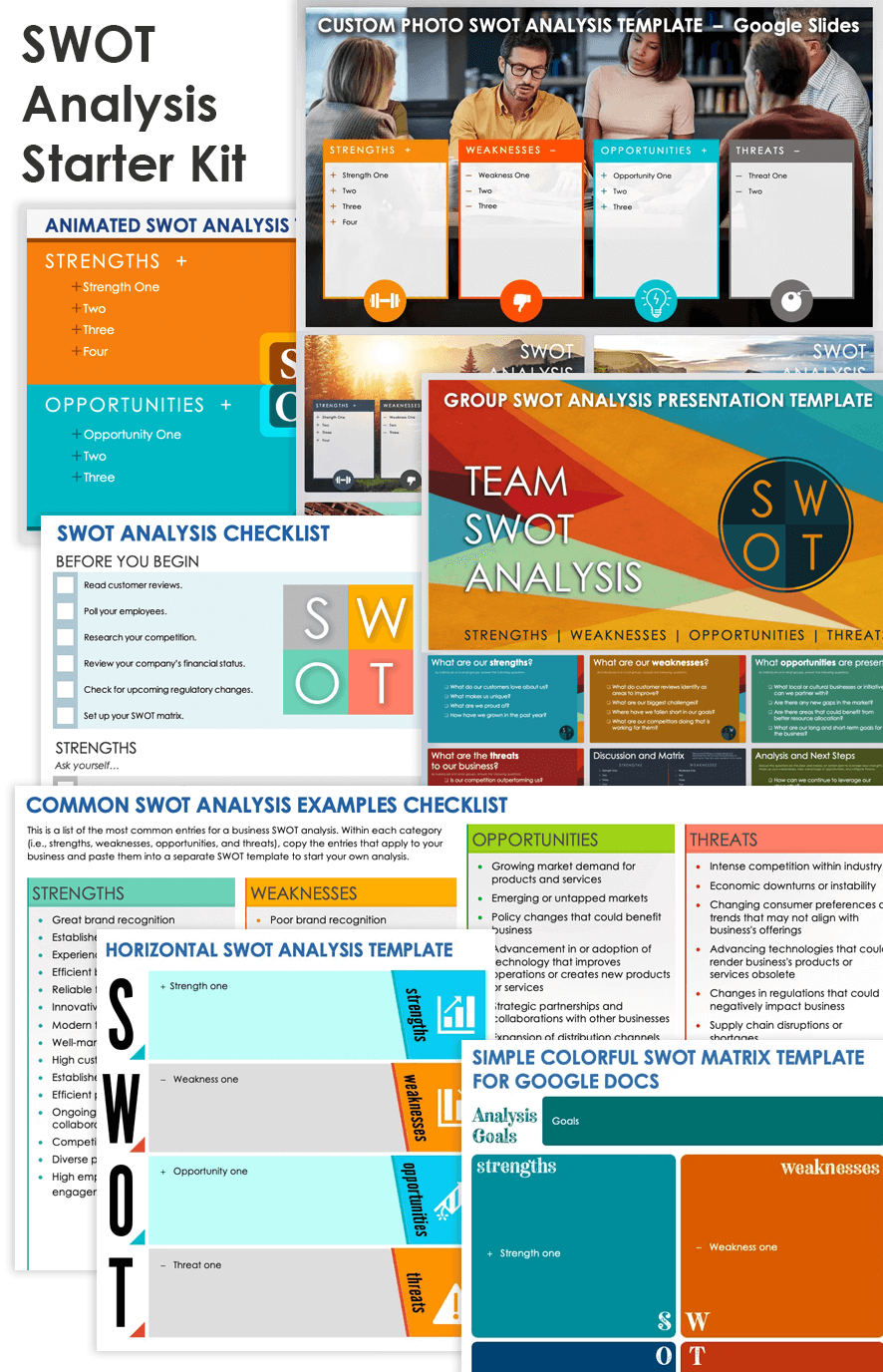
Download the SWOT Analysis Starter Kit
We’ve created this starter kit to give you the necessary tools to think through and conduct a SWOT analysis for your business. You’ll find SWOT templates in multiple formats, a checklist of actions to take and questions to ask, and a presentation template. All of these templates are fully customizable and can be adapted for personal decision-making. Download each template individually or as a complete kit.
Included in this download, you’ll find:
- A blank animated SWOT analysis template for PowerPoint to help create an engaging SWOT presentation.
- A blank horizontal, landscape-oriented SWOT analysis template for Microsoft Word to create an eye-catching display or a handout with plenty of room for text.
- A blank simple, portrait-oriented SWOT matrix template for Microsoft Word and Google Docs for easy brainstorming and sharing.
- A blank custom photo SWOT matrix template for PowerPoint and Google Slides to create a dynamic, personalized presentation of your analysis.
- A SWOT analysis checklist for Microsoft Word so that each step of your analysis goes off without a hitch.
- A common SWOT analysis examples checklist for Microsoft Word to reference and copy from when completing your SWOT template.
- A group SWOT analysis presentation for PowerPoint to help facilitate a group SWOT analysis meeting.
SWOT Analysis Examples
A SWOT analysis can help a wide variety of businesses identify their strengths, weaknesses, opportunities, and threats. We’ve collected some SWOT analysis examples that demonstrate how they’re used in construction, technology, and retail industries.
Construction Company SWOT Analysis Example for Google Docs

Download the Simple Colorful Construction Company SWOT Template for Google Docs Download the Simple Colorful Construction Company SWOT Template for Google Docs with Sample Data
This simple but colorful SWOT template includes example data for a construction company concerned about its growth. In the sample, the company has identified the experience of their staff as a strength, as well as their growth as a business over the last 15 years. They know they need to be more open to adopting new technology, and they acknowledge they have no marketing budget and only attract new clients by word-of-mouth. They use this info to focus their opportunities on leveraging their existing staff to train new teams, and creating a specific budget for marketing. Finally, they have identified the rising costs of labor and the chance of public backlash to a project they are working on as threats to their business.
Technology Company SWOT Analysis Example for PowerPoint
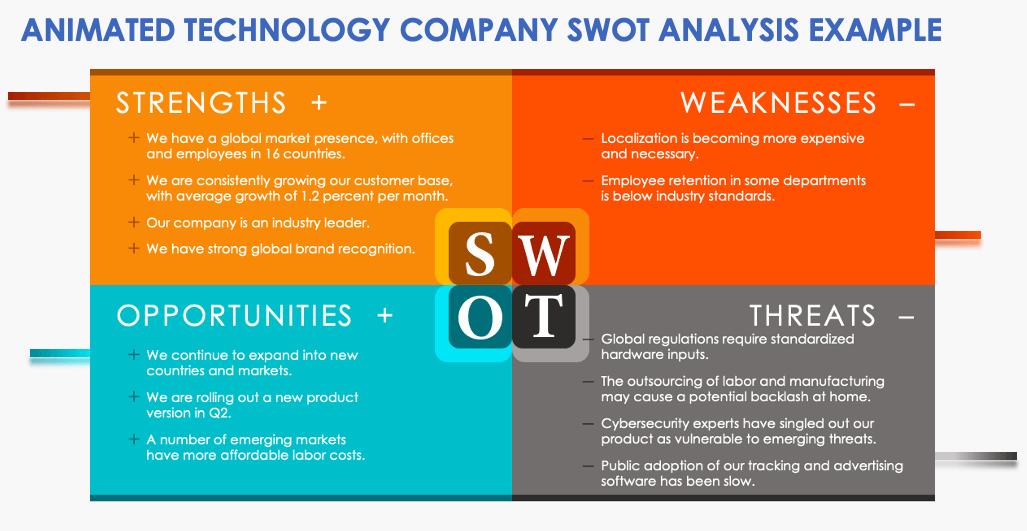
Download the Blank Animated Technology SWOT Analysis for PowerPoint Download the Animated Technology SWOT Analysis Template for PowerPoint with Sample Data
This animated SWOT analysis template is excellent for showing off your SWOT findings in a meeting or presentation setting. It includes animations to reveal each quadrant of your matrix as you speak. This template includes sample data for a large technology company that has recognized its worldwide presence and growing customer base as strengths, and the requirements of localization and employee retention as weaknesses. The organization is looking ahead to the opportunities presented by decreased labor costs in emerging markets, but also paying attention to the threat of cybersecurity and potential backlash in their home country due to their outsourcing of labor and manufacturing.
Retail Company SWOT Analysis Example for Microsoft Word
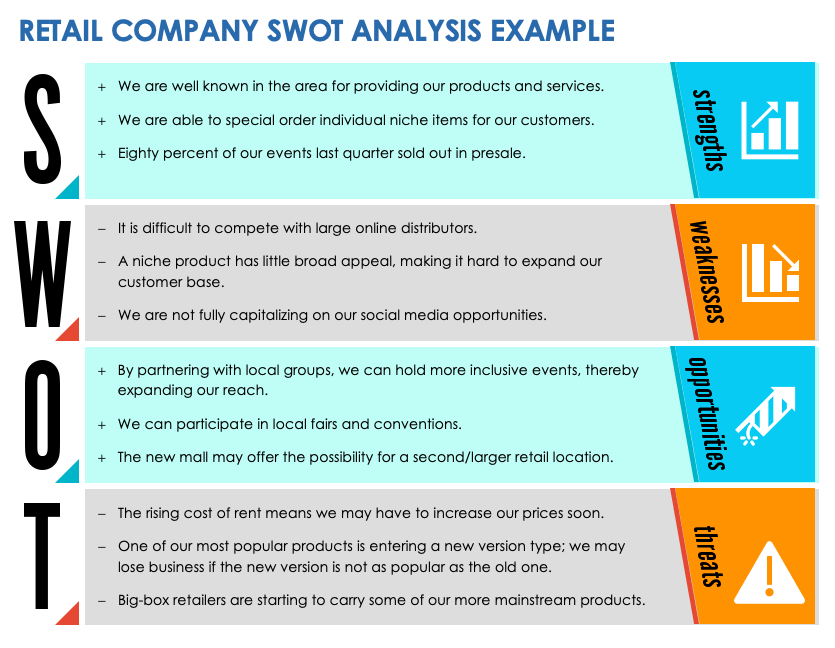
Download the Blank Horizontal Retail SWOT Template for Microsoft Word Download the Horizontal Retail SWOT Template for Microsoft Word with Sample Data
This horizontal-oriented SWOT template includes example data for a retail store. In the sample version of the template, the store has outlined its strengths but also noted concerns about the rising costs of rent and the abundance of big-box stores and included those in the threats section. They have identified opportunities as participation in local events and the possibility of a second storefront. The store also recognized that it could improve its social media efforts and the difficulty in competing with larger, online retailers.
What Is a SWOT Analysis?
A SWOT analysis is a strategic assessment tool that weighs strengths, weaknesses, opportunities, and threats to aid in decision-making. A SWOT analysis can help guide you to better-informed conclusions that are more likely to produce long-term benefits.
Invented by Albert Humphrey at the Stanford Research Institute in the 1960s, the SWOT analysis framework has been adopted by businesses and individual decision-makers worldwide. Humphrey’s framework prioritizes the analysis of internal strengths and weaknesses; the related TOWS analysis model flips this on its head and focuses on external opportunities and threats. Another external analysis model, the PEST (political, economic, social, and technological) framework, focuses entirely on external factors, namely political, economical, sociocultural, and technological.
“The SWOT analysis is an excellent framework not only for diagnosing issues in your business, but also for identifying strategic opportunities within it. For example, a SWOT analysis can be applied to the launch of a new product, a business partnership under consideration, or a key hire or promotion. While the SWOT is not meant to be an all-inclusive, fully exhaustive analysis, it does provide a solid basis for discussion, much like a resume or CV contributes to the hiring process,” explains Colleti of Colletti Labs.
Strength in a SWOT Analysis
The strengths section of a SWOT analysis highlights what you do well. These can include your sales and market presence, hiring and retention practices, and products and services, among others. It can also list what you are good at personally.
Some additional examples of strengths you might list in a SWOT analysis include:
- Customer Satisfaction: Satisfied customers are returning customers. Returning customers keep your business solvent. Having a large number of regular customers is a great strength.
- Effective Branding: The right branding makes a business memorable. A well-designed logo or a fun, topical ad campaign can bring in sales and create positive associations with your brand.
- Employee Satisfaction and Retention: Hiring quality talent and retaining them for the long term is a wonderful strength. Loyal employees are more likely to enjoy their work and work harder because of it.
- Expertise: Business leaders often have expertise in their field that translates to a better product or service. Possessing more expertise than your competitors is a noteworthy strength.
- Filling a Niche: Identifying and filling a niche in the market is an excellent strength. Many businesses thrive because they are able to tap into the needs of their market and provide it for their customers.
- Leadership: Great leadership is a great strength. Leaders who inspire and support their teammates foster a happier and more cohesive workplace.
- Longevity: The longer your business has been around, the longer you have had to cultivate a positive reputation in your community. Businesses often celebrate their anniversaries and promote the time they have spent operating in the community. Longevity helps assure customers that you have expertise in your niche.
- Meeting and Exceeding Goals: Setting and achieving realistic goals is a sign of a well-run business.
- Product and Service Offerings: Unique or popular product and service offerings help a business carve out a niche and find their customer base, making them an obvious strength.
- Sales: Consistently high sales are desirable for any business and, therefore, a major strength. Robust sales can also lead to many other strengths, as well.
Identifying strengths impartially can be challenging. Use this list of questions to help pinpoint your strengths:
- How has your company grown?
- What do your customers like about you in reviews?
- What do your employees like about working for you?
- What does your company do that is unique?
- What offerings or company philosophies set you apart?
- What looks different about your business from one, five, and ten years ago?
Weakness in a SWOT Analysis
Weaknesses in a SWOT analysis are business aspects that are underperforming. These could be low sales, unpopular services, limitations, negative reviews, or others. Consider your weaknesses carefully, as you can often turn them into opportunities.
Here’s a list of common weaknesses businesses might find in a SWOT analysis:
- Employee Satisfaction: Employees who are unhappy with their jobs are less engaged and less productive. Consider your employees’ satisfaction, as retention can easily become a weakness of the business.
- Inefficient Budget and Resource Allocation: Many businesses have enough but do not allocate them efficiently. This weakness can be easily addressed by implementing better project prioritization practices.
- Negative Customer Reviews: Look at what your customers are saying in their reviews. Note the comments that show up frequently, and remember that customers will only typically leave very positive or very negative reviews. Use negative reviews as a tool to identify the areas where your business can improve.
- Not Reading Trends: Your products and services can quickly become obsolete if you are not in the habit of reading and forecasting trends.
- Poor Branding: Consider branding carefully. It should be consistent, representative of your company, and recognizable across all mediums.
- Poor Leadership: Solid leadership is critical to the success of a business. As such, leadership that doesn’t perform well should be addressed immediately.
- Product or Service Offerings: Product or service offerings can be a weakness if they are not unique to your business or better than similar offerings from your competitors.
- Resource Limitations: Resources might include money, people, or materials. If you do not have the resources needed to meet demand, shore up this weakness.
- Rigidity: Being unable or unwilling to change with the times is a weakness found in many organizations. Change can be scary, but it is often required to move forward and stay relevant.
- Unrealistic Sales Projections: When sales are lower than projected, it can throw off budgets and plans for the business’s future, leading to missed opportunities and overinvestment in failing product lines.
Business owners often struggle to identify their weaknesses impartially. To help identify weaknesses, ask yourself the following questions, and be honest with your answers:
- What do your customers think you can improve on?
- What part of your business do customers commonly identify as troublesome?
- What are your biggest challenges?
- Where have you fallen short in your goals over time? Were those goals realistic?
- What are your competitors doing better than you?
- What are your competitors doing that you wish you were doing better?
- When was the last time you performed a competitive analysis ?
- What do your employees think of their leaders and your business?
Opportunities in a SWOT Analysis
In a SWOT analysis, opportunities refer to situations that offer a chance to improve or expand. These can be factors such as a gap in the market, new products or services, or positive media coverage.
Some examples of opportunities to note in your SWOT analysis are:
- New Products and Services: When you add new products or services to your offerings, you have an opportunity to expand your product line and grow your business.
- Social Media Engagement: Social media provides an organic way to interact with existing and potential customers in a casual setting.
- Viral Advertising: Many businesses find success after creating popular media on the internet. Viral advertising has the potential to expose your company to potential customers who might otherwise not find you.
- Competition Gaps: Pay attention to your competition. When they switch gears or leave the market, you might be able to fill the gap they leave behind.
- Surplus Budget Reallocation: Sometimes a business finds it has a budget surplus. Extra money is an opportunity to shore up weak spots or take advantage of new opportunities.
- Partnerships: Partnering with other businesses or causes can bring you the exposure you could not have found alone. Fundraising and profit sharing offer beneficial ways to build some community support and help a good cause.
- Social and Cultural Opportunities: In addition to partnering with other businesses, research events and causes within your community that could help grow your business. Participating in social and cultural events can help boost your community standing.
- Hiring Consultants: You cannot be an expert in everything, so consider hiring an experienced authority to handle the tricky stuff or to teach you how to handle it.
- Training and Education: Continuing training and education of your staff (and yourself) can lead to countless future opportunities.
- Expansion: One of the most common, and most desirable, opportunities for a business is the chance to open new locations or expand into new markets.
To identify opportunities present in your business, ask the following questions:
- Which social media platforms have shown the most growth in followers and engagement?
- Are there areas of local or cultural impact we can highlight in our messaging?
- Is there any kind of gap in the market we can capitalize on?
- Is there a budget surplus in a department that can be allocated elsewhere?
- Are there other companies or organizations we can partner with for shared impact?
- What are our long- and short-term goals for the business?
- How can we best achieve our goals with our current resources?
Threat in a SWOT Analysis
Threats in a SWOT analysis refer to events or circumstances that pose a risk to your business’s growth or commercial success. These can include competitors, new regulations, negative media or social media coverage, and customer and employee satisfaction.
Opportunities and threats are sometimes considered two sides of the same coin, as many opportunities invite risk if you do not meet them with a solid plan. Opportunities are chances to capitalize on a possibility, but they can often be safely ignored. On the other hand, if you ignore threats for long enough, they often lead to disastrous consequences. Threats vary by industry and location.
We’ve collected some examples of common threats that could appear in a SWOT analysis:
- Competition: Your competition is always a threat. Other businesses occupying the same market space can dilute sales or push you out altogether. Monitor your competition’s offerings so that you can adjust as needed and stay relevant.
- Customer Satisfaction: Many factors can affect customer satisfaction, but as your clients become less satisfied, they are less likely to patronize your business. Keep an eye on reviews, social media, and customer surveys for insights into your customers’ experiences.
- Employee Satisfaction: Without experienced and motivated staff, it is impossible to operate efficiently. Keep employees satisfied by providing competitive wages, opportunities for growth, and positive reinforcement of their achievements.
- Environmental: Prepare a plan for major weather or environmental events, even if you don’t operate your business where they are common. If possible, carry insurance for fires, floods, and earthquakes so that your work is interrupted as little as possible if one occurs.
- Equipment and Building Maintenance: Delaying expensive repairs and maintenance on your buildings or equipment that are not immediately critical can be tempting. However, putting them off too long can lead to even more expensive repairs and possible closures at a later date when things break down or fail.
- Media Coverage: The adage “no such thing as bad press” is not always true. Negative media coverage can cost you customers and sales. Positive media coverage can run the risk of bringing on more customers than you have the capacity to handle, which can lead to frustration and a loss of customers in kind.
- Regulations: New regulations that interfere with or inhibit your business get passed all the time. Keep abreast of any pending changes, and be sure that you have contingency plans in place.
- Setting Financial Goals: Your business forecasts should be realistic and based on similar market numbers or real numbers you have achieved in the past. You cannot set achievable plans for your business's future if you are not making accurate projections in the present.
- Social Media Coverage: Like regular media coverage, social media can make or break your business. Many companies find success and followings on social media organically. However, some fail to appeal to the average user and can even find themselves publicly ridiculed in this forum instead.
- Supply Chain Delays: Supply chain delays can affect lead times, manufacturing schedules, and the availability of materials. They can be difficult to predict, so consider building in extra time or creating contingency plans.
Identifying threats can feel overwhelming and pessimistic, but they are vital for business planning. Ask yourself the following questions to shine light on potential threats in your SWOT analysis:
- Are there any new major competitors in the market?
- What are people saying about us in reviews and on social media?
- Where are we underperforming?
- Where are we missing our goals?
- Will any incoming new legislation directly or indirectly affect our business? What kind of potential legislative changes should we keep an eye on?
- Are we keeping up to date on building and equipment maintenance?
- Are our employees satisfied with their jobs?
- Are we maintaining accurate financial records and creating accurate projections?
Internal and External Factors in a SWOT Analysis
In a SWOT analysis, strengths and weaknesses are considered internal factors, and opportunities and threats are considered external factors. Internal factors are usually a result of decisions the company has made. External factors often come from a wider environment.
Internal factors tend to be easier to address since they come from decisions made within the company. External factors depend greatly on factors outside of a business and can be harder to identify and track. As a result, most organizations find it easier to bolster strengths and shore up weaknesses than to take advantage of opportunities and avoid threats.
Tips for Writing a SWOT Analysis
To write a SWOT analysis for your business, take an objective look at your strengths, weaknesses, opportunities, and threats. Keep it organized and concise, and create a specific and actionable list.
We’ve outlined these and other tips:
- Be Concise: Stick to the most profound or critical five or six elements in each quadrant to keep the analysis relevant and actionable.
- Be Honest and Impartial: It’s vital to be honest and impartial about the state of your business. This truth can sometimes be difficult for managers and owners who are too close to it, so consider involving additional stakeholders or employing outside help.
- Be Specific: Use real numbers when talking about sales, goals, and times. Point to specific initiatives that were successful (or not) instead of referring to them broadly. “My early SWOT analyses were too general, and I didn’t have the rigor that’s required to provide a detailed and balanced view of a business or opportunity. If I could go back in time, I would consider more elements of the business, including people, product, marketing, sales, customer service, data management, quality, partners, etc. I would also provide metrics and KPIs for each area discussed to provide a proper data-driven basis for discussion or debate,” Colletti contemplates.
- Do It Regularly: Create a quarterly or annual schedule to perform SWOT analyses regularly. “I wish I had known that a SWOT analysis should be performed at regular intervals,” says Wesman. “Changes in technology, consumer sentiment, and macroeconomic factors can drastically alter a business's prior prospects, which can blindside decision-makers during their most critical moments.”
- Follow Up: Once you analyze your results, make an action plan to take advantage of your strengths and opportunities, as well as to address any shortcomings you have found. Use it to help plan your business strategy going forward. “A SWOT analysis is a great way to keep your finger on the pulse of your business’s overall performance,” says Rossi.
- Use Real Data: Use real data from reviews, surveys, and sales to create the analysis. Your SWOT analysis will be more actionable if you include the real numbers associated with each factor.

Mistakes to Avoid when Doing a SWOT Analysis
When performing a SWOT analysis, avoid being vague or too verbose. Be sure to follow up on the findings and create an action plan.
We’ve outlined these and other potential mistakes to avoid in your SWOT analysis:
- Being Too Wordy: Your lists should be easy to read and understand without a lot of extra information. Use real numbers and statistics when applicable, and stick to the top five or six items with the most impact in each quadrant.
- Being Too Vague: At the same time, your lists should include all the necessary details to give the reader the full picture.
- Not Being Honest and Objective: It is easy to inflate your strengths and downplay your weaknesses, but that will only hurt your business in the long term. “One common mistake is to downplay the risks and threats in the analysis. As entrepreneurs, we sometimes tend to be overly optimistic or overconfident. We may want to embellish the strengths and opportunities, such as stating ‘our killer technology’ or ‘our amazing sales team.’ Another mistake is to make claims or statements with no real data or analytical support. A proper SWOT requires you to be pragmatic about your strengths, and think really hard about what risks and threats face your business,” explains Colletti.
- Not Creating an Action Plan: One of the biggest mistakes you can make with a SWOT analysis is not using its results to inform your next steps. A SWOT analysis is only useful if you learn from it and let it help you inform your strategy.
- Not Involving a Group: A SWOT analysis performed by a single person will only have a single point of view. For best results, take a more inclusive look at your business from people at all levels.
Benefits of a SWOT Analysis
A SWOT analysis can provide insight into your business’s overall performance, highlight places to improve, and even act as a team-building exercise.
We’ve outlined these and more benefits of performing a SWOT analysis:
- Develop Action Plans: A SWOT analysis is a great tool for developing an action plan. Use the results to focus on the areas that need work or extra resources and to keep developing the areas that are doing well.
- Do Some Introspection: A SWOT analysis provides a forum to do some real introspection on your business and its practices. “Since many entrepreneurs and business owners can be overly optimistic, a SWOT analysis can help force pragmatism. Leaders need to consider the business from all angles with a heightened sense of rigor,” warns Colletti.
- Get an Objective Overview of the Business: A SWOT analysis can give you an overview of your company’s current performance and its future potential. “You can use these insights to weigh the pros and cons of difficult business decisions. This will help you navigate challenging market environments to your advantage,” says Wesman.
- Help Draft Other Business Documents: A SWOT analysis can serve as the first draft for other business documents, such as project overviews, media releases, and investment reports. “SWOT is a widely known framework, thus providing a common language for communicating the viability of a business or opportunity to leadership, investors, business partners, or board members,” explains Colletti.
- Team Building: When you include a diverse group of employees in business strategy discussions, you increase their buy-in and engagement. They feel more connected to the problem and see themselves as part of the solution. “SWOT is an excellent tool for a strategy session or team-building event , allowing leaders to solicit input and feedback on various aspects of the business,” Colletti explains.
Turn Your Brainstorm into a Plan of Action with the Smartsheet for Miro Integration
Empower your people to go above and beyond with a flexible platform designed to match the needs of your team — and adapt as those needs change.
The Smartsheet platform makes it easy to plan, capture, manage, and report on work from anywhere, helping your team be more effective and get more done. Report on key metrics and get real-time visibility into work as it happens with roll-up reports, dashboards, and automated workflows built to keep your team connected and informed.
When teams have clarity into the work getting done, there’s no telling how much more they can accomplish in the same amount of time. Try Smartsheet for free, today.
Discover why over 90% of Fortune 100 companies trust Smartsheet to get work done.
SWOT Analysis: How To Do One [With Template & Examples]
Published: October 05, 2023
As your business grows, you need a roadmap to help navigate the obstacles, challenges, opportunities, and projects that come your way. Enter: the SWOT analysis.

This framework can help you develop a plan to determine your priorities, maximize opportunities, and minimize roadblocks as you scale your organization. Below, let’s go over exactly what a SWOT analysis is, a few SWOT analysis examples, and how to conduct one for your business.
![swot analysis term paper → Download Now: Market Research Templates [Free Kit]](https://no-cache.hubspot.com/cta/default/53/6ba52ce7-bb69-4b63-965b-4ea21ba905da.png)
When you’re done reading, you’ll have all the inspiration and tactical advice you need to tackle a SWOT analysis for your business.
What is a SWOT analysis? Importance of a SWOT Analysis How to Write a Good SWOT Analysis SWOT Analysis Examples How to Act on a SWOT Analysis
What is a SWOT analysis?
A SWOT analysis is a strategic planning technique that puts your business in perspective using the following lenses: Strengths, Weaknesses, Opportunities, and Threats. Using a SWOT analysis helps you identify ways your business can improve and maximize opportunities, while simultaneously determining negative factors that might hinder your chances of success.
While it may seem simple on the surface, a SWOT analysis allows you to make unbiased evaluations on:
- Your business or brand.
- Market positioning.
- A new project or initiative.
- A specific campaign or channel.
Practically anything that requires strategic planning, internal or external, can have the SWOT framework applied to it, helping you avoid unnecessary errors down the road from lack of insight.
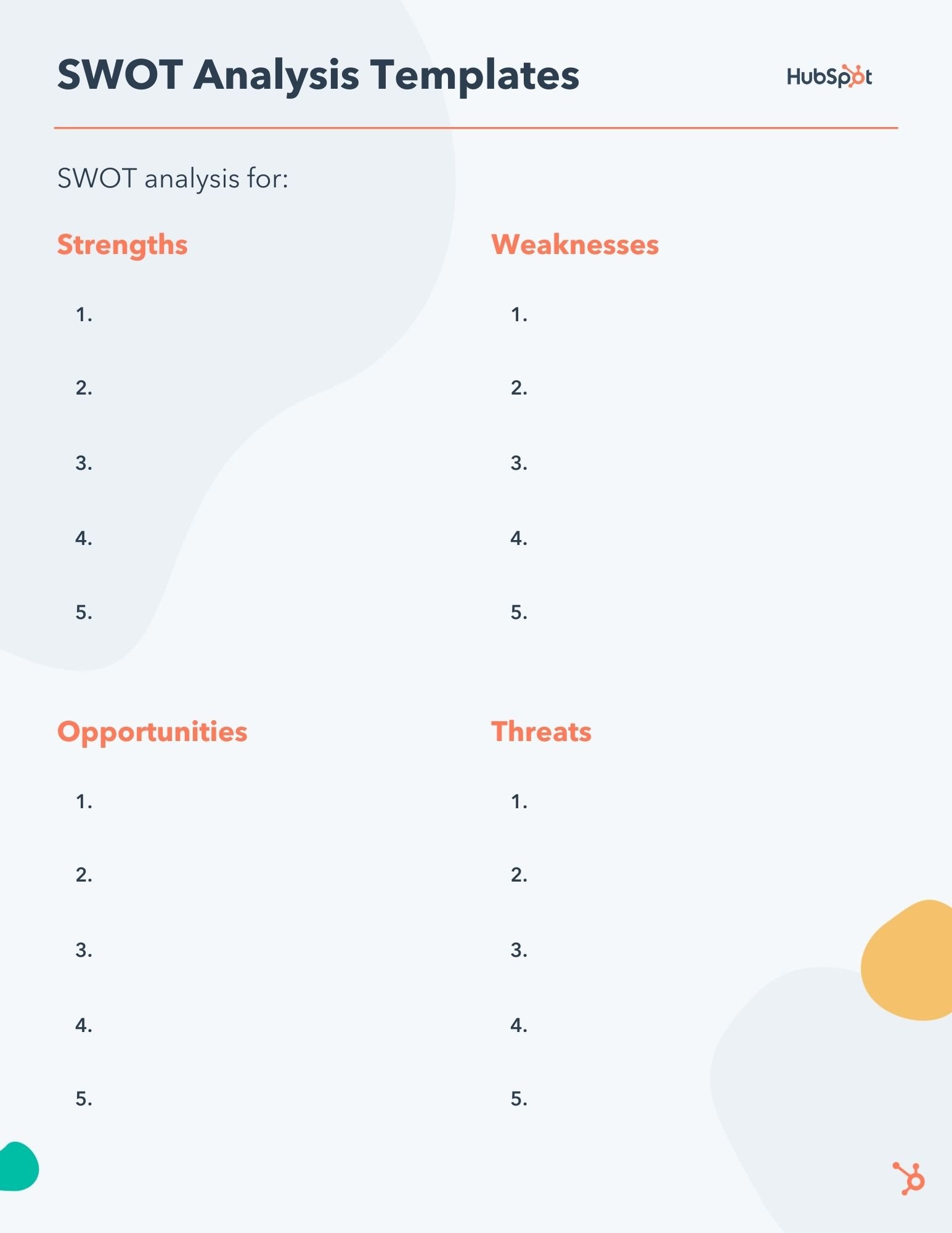
Free SWOT Analysis Template
A free SWOT analysis template, plus other helpful market research resources.
Opportunities
You're all set.
Click this link to access this resource at any time.
Importance of a SWOT Analysis
You’ve noticed by now that SWOT stands for Strengths, Weaknesses, Opportunities, and Threats. The framework seems simple enough that you’d be tempted to forgo using it at all, relying instead on your intuition to take these things into account.
But you shouldn’t. Doing a SWOT analysis is important. Here’s why.
SWOT gives you the chance to worry and to dream.
A SWOT analysis is an important step in your strategic process because it gives you the opportunity to explore both the potential risks and the exciting possibilities that lie ahead. You’re giving yourself the space to dream, evaluate, and worry before taking action. Your insights then turn into assets as you create the roadmap for your initiative.
For instance, when you consider the weaknesses and threats that your business may face, you can address any concerns or challenges and strategize on how to mitigate those risks. At the same time, you can identify strengths and opportunities, which can inspire innovative ideas and help you dream big. Both are equally important.
SWOT forces you to define your variables.
Instead of diving head first into planning and execution, you’re taking inventory of all your assets and roadblocks. This process will help you develop strategies that leverage your strengths and opportunities while addressing and mitigating the impact of weaknesses and threats.
As a result, you'll gain a comprehensive understanding of your current situation and create a more specific and effective roadmap. Plus, a SWOT analysis is inherently proactive. That means you'll be better equipped to make informed decisions, allocate resources effectively, and set realistic goals.
SWOT allows you to account for mitigating factors.
As you identify weaknesses and threats, you’re better able to account for them in your roadmap, improving your chances of success.
Moreover, accounting for mitigating factors allows you to allocate your resources wisely and make informed decisions that lead to sustainable growth. With a SWOT analysis as a guide, you can confidently face challenges and seize opportunities.
SWOT helps you keep a written record.
As your organization grows and changes, you’ll be able to strike things off your old SWOTs and make additions. You can look back at where you came from and look ahead at what’s to come.
In other words, SWOT analyses serve as a tangible history of your progress and provide a reference point for future decision-making. With each update, your SWOT analysis becomes a living document that guides your strategic thinking and helps you stay agile and adaptable in an ever-changing business landscape.
By maintaining this written record, you foster a culture of continuous improvement and empower your team to make data-driven decisions and stay aligned with your long-term vision.
Parts of a SWOT Analysis
Conducting a SWOT analysis will help you strategize effectively, unlock valuable insights, and make informed decisions. But what exactly does a SWOT analysis include?
Let’s explore each component: Strengths, Weaknesses, Opportunities, and Threats.
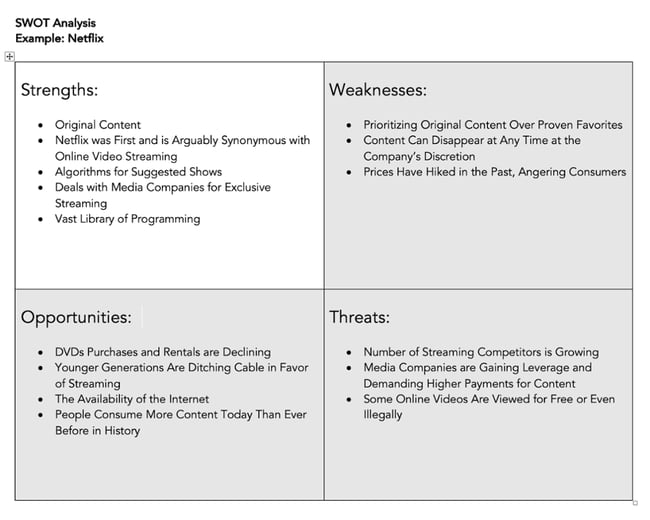
Your strengths are the unique advantages and internal capabilities that give your company a competitive edge in the market. A strong brand reputation, innovative products or services, or exceptional customer service are just a few examples. By identifying and capitalizing on your strengths, you can foster customer loyalty and build a solid foundation for growth.
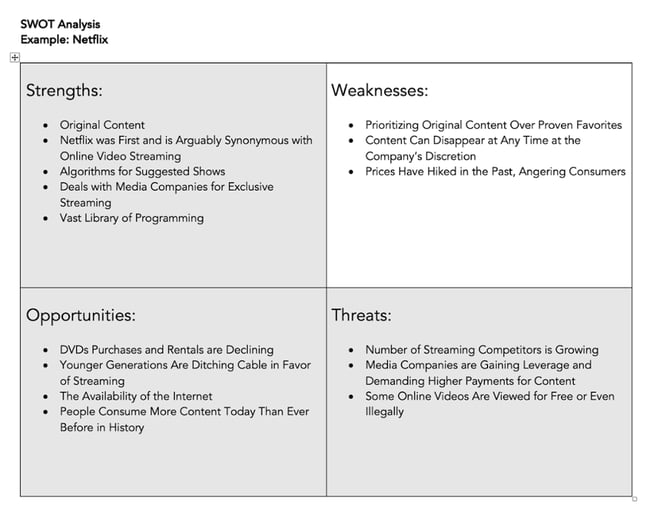
No business is flawless. Weaknesses are areas where you may face challenges or fall short of your potential. It could be outdated processes, skill gaps within the team, or inadequate resources. By acknowledging these weaknesses, you can establish targeted initiatives for improvement, upskill your team, adopt new technologies, and enhance your overall operational efficiency.
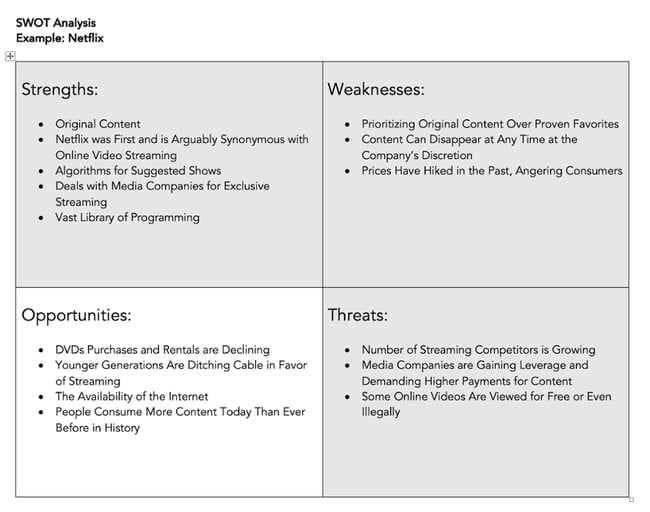
Opportunities are external factors that can contribute to your company's progress. These may include emerging markets, technological advancements, changes in consumer behavior, or gaps in the market that your company can fill. By seizing these opportunities, you can expand your market reach, diversify your product offerings, forge strategic partnerships, or even venture into untapped territories.
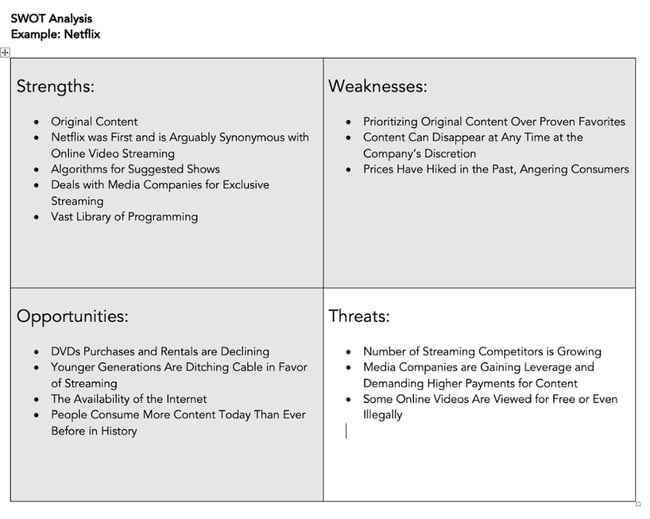
Threats are external factors that are beyond your control and pose challenges to your business. Increased competition, economic volatility, evolving regulatory landscapes, or even changing market trends are examples of threats. By proactively assessing and addressing them, you can develop contingency plans, adjust your strategies, and minimize their impact on your operations.
In a SWOT analysis, you’ll have to take both internal and external factors into account. We’ll cover those next.
.png)
Free Market Research Kit
5 Research and Planning Templates + a Free Guide on How to Use Them in Your Market Research
- SWOT Analysis Template
- Survey Template
- Focus Group Template
SWOT Analysis Internal and External Factors
A SWOT analysis typically has internal (i.e., within your organization) and external (i.e., outside your organization) factors at play. Here's a breakdown of each.
Internal Factors
Internal factors refer to the characteristics and resources within your organization that directly influence its operations and performance. These factors are completely within your organization's control, so they can be modified, improved, or capitalized upon.
In a SWOT analysis, strengths and weaknesses are categorized as internal factors. Let’s look at a few examples.
- Brand reputation
- Unique expertise
- Loyal customer base
- Talented workforce
- Efficient processes
- Proprietary technology
- Outdated technology
- Inadequate resources
- Poor financial health
- Inefficient processes
- Skill gaps within the team
External Factors
External factors are elements outside the organization's control that have an impact on its operations, market position, and success. These factors arise from the industry climate and the broader business environment. You typically have no control over external factors, but you can respond to them.
In a SWOT analysis, opportunities and threats are categorized as external factors. Let’s look at a few examples.
- Emerging markets
- Changing consumer trends
- Technological advancements
- Positive shifts in regulations
- New gaps in the market you could fill
- Intense competition
- Economic downturns
- Disruptive technologies
- Changing regulations
- Negative shifts in consumer behavior
Remember, a well-rounded SWOT analysis empowers you to capitalize on strengths, address weaknesses, seize opportunities, and navigate threats — all while making informed decisions for the future.
Now, let’s take a look at how you can write a good SWOT analysis for yourself or for stakeholders.
How do you write a good SWOT analysis?
There are several steps you’ll want to take when evaluating your business and conducting a strategic SWOT analysis.
1. Download HubSpot's SWOT Analysis Template.
There’s no need to start from scratch for your analysis. Instead, start by downloading a free, editable template from HubSpot. Feel free to use the model yourself, or create your own as it suits your needs.
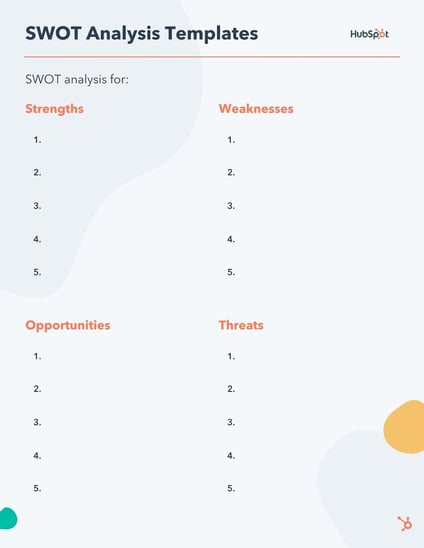
3. Identify your objective.
Before you start writing things down, you’ll need to figure out what you’re evaluating with your SWOT analysis.
Be specific about what you want to analyze. Otherwise, your SWOT analysis may end up being too broad, and you’ll get analysis paralysis as you are making your evaluations.
If you’re creating a new social media program, you’ll want to conduct an analysis to inform your content creation strategy. If you’re launching a new product, you’ll want to understand its potential positioning in the space. If you’re considering a brand redesign, you’ll want to consider existing and future brand conceptions.
All of these are examples of good reasons to conduct a SWOT analysis. By identifying your objective, you’ll be able to tailor your evaluation to get more actionable insights.
4. Identify your strengths.
“Strengths” refers to what you are currently doing well. Think about the factors that are going in your favor as well as the things you offer that your competitors just can’t beat.
For example, let’s say you want to use a SWOT analysis to evaluate your new social media strategy.
If you’re looking at a new social media program, perhaps you want to evaluate how your brand is perceived by the public. Is it easily recognizable and well-known? Even if it’s not popular with a widespread group, is it well-received by a specific audience?
Next, think about your process: Is it effective or innovative? Is there good communication between marketing and sales?
Finally, evaluate your social media message, and in particular, how it differs from the rest of the industry. I’m willing to bet you can make a lengthy list of some major strengths of your social media strategy over your competitors, so try to dive into your strengths from there.
5. Identify your weaknesses.
In contrast to your strengths, what are the roadblocks hindering you from reaching your goals? What do your competitors offer that continues to be a thorn in your side?
This section isn’t about dwelling on negative aspects. Rather, it’s critical to foresee any potential obstacles that could mitigate your success.
When identifying weaknesses, consider what areas of your business are the least profitable, where you lack certain resources, or what costs you the most time and money. Take input from employees in different departments, as they’ll likely see weaknesses you hadn’t considered.
If you’re examining a new social media strategy, you might start by asking yourself these questions: First, if I were a consumer, what would prevent me from buying this product, or engaging with this business? What would make me click away from the screen?
Second, what do I foresee as the biggest hindrance to my employees’ productivity, or their ability to get the job done efficiently? What derails their social media efforts?
6. Consider your opportunities.
This is your chance to dream big. What are some opportunities for your social media strategy you hope, but don’t necessarily expect, to reach?
For instance, maybe you’re hoping your Facebook ads will attract a new, larger demographic. Maybe you’re hoping your YouTube video gets 10,000 views and increases sales by 10%.
Whatever the case, it’s important to include potential opportunities in your SWOT analysis. Ask yourself these questions:
- What technologies do I want my business to use to make it more effective?
- What new target audience do I want to reach?
- How can the business stand out more in the current industry?
- Is there something our customers complain about that we could fix?
The opportunities category goes hand-in-hand with the weaknesses category. Once you’ve made a list of weaknesses, it should be easy to create a list of potential opportunities that could arise if you eliminate your weaknesses.
7. Contemplate your threats.
It’s likely, especially if you’re prone to worry, you already have a good list of threats in your head.
If not, gather your employees and brainstorm. Start with these questions:
- What obstacles might prevent us from reaching our goals?
- What’s going on in the industry, or with our competitors, that might mitigate our success?
- Is there new technology out there that could conflict with our product?
Writing down your threats helps you evaluate them objectively.
For instance, maybe you list your threats in terms of least and most likely to occur and divide and conquer each. If one of your biggest threats is your competitor’s popular Instagram account, you could work with your marketing department to create content that showcases your product’s unique features.
SWOT Analysis Chart
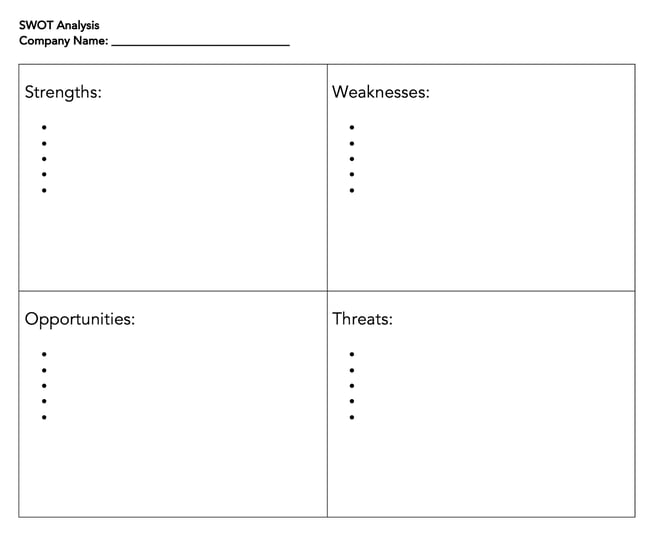
Download a free SWOT analysis chart included in HubSpot’s free market research kit .
A SWOT analysis doesn’t have to be fancy. Our SWOT analysis chart provides a clear and structured framework for capturing and organizing your internal strengths and weaknesses, and external opportunities and threats. It's the perfect visual aid to make sense of the wealth of information gathered during your analysis.
(Plus, you can always customize and paste it into a document you plan to share with stakeholders.)
But remember: Filling out the SWOT chart is just one step in the process. Combine it with our entire market research kit , and you'll have all the tools necessary to help your organization navigate new opportunities and threats.
SWOT Analysis Examples
The template above helps get you started on your own SWOT analysis.
But, if you’re anything like me, it’s not enough to see a template. To fully understand a concept, you need to see how it plays out in the real world.
These SWOT examples are not exhaustive. However, they are a great starting point to inspire you as you do your own SWOT analysis.
Apple’s SWOT analysis
Here’s how we’d conduct a SWOT analysis on Apple.

First off, strengths. While Apple has many strengths, let’s identify the top three:
- Brand recognition.
- Innovative products.
- Ease of use.
Apple’s brand is undeniably strong, and its business is considered the most valuable in the world . Since it’s easily recognized, Apple can produce new products and almost ensure a certain degree of success by virtue of the brand name itself.
Apple’s highly innovative products are often at the forefront of the industry. One thing that sets Apple apart from the competition is its product inter-connectivity.
For instance, an Apple user can easily sync their iPhone and iPad together. They can access all of their photos, contacts, apps, and more no matter which device they are using.
Lastly, customers enjoy how easy it is to use Apple’s products. With a sleek and simple design, each product is developed so that most people can quickly learn how to use them.
Next, let’s look at three of Apple’s weaknesses.
- High prices
- Closed ecosystem
- Lack of experimentation
While the high prices don’t deter Apple’s middle- and upper-class customer base, they do hinder Apple’s ability to reach a lower-class demographic.
Apple also suffers from its own exclusivity. Apple controls all its services and products in-house, and while many customers become loyal brand advocates for this reason, it means all burdens fall on Apple employees.
Ultimately, Apple’s tight control over who distributes its products limits its market reach.
Lastly, Apple is held to a high standard when it comes to creating and distributing products. Apple’s brand carries a high level of prestige. That level of recognition inhibits Apple from taking risks and experimenting freely with new products that could fail.
Now, let’s take a look at opportunities for Apple.
It’s easy to recognize opportunities for improvement, once you consider Apple’s weaknesses. Here’s a list of three we came up with:
- Expand distribution options.
- Create new product lines.
- Technological advancement.
One of Apple’s biggest weaknesses is its distribution network, which, in the name of exclusivity, remains relatively small. If Apple expanded its network and enabled third-party businesses to sell its products, it could reach more people globally, while alleviating some of the stress currently put on in-house employees.
There are also plenty of opportunities for Apple to create new products. Apple could consider creating more affordable products to reach a larger demographic, or spreading out into new industries — Apple self-driving cars, perhaps?
Finally, Apple could continue advancing its products’ technology. Apple can take existing products and refine them, ensuring each product offers as many unique features as possible.
Finally, let’s look at threats to Apple.
Believe it or not, they do exist.
Here are three of Apple’s biggest threats:
- Tough competition.
- International issues.
Apple isn’t the only innovative tech company out there, and it continues to face tough competition from Samsung, Google, and other major forces. In fact, Samsung sold more smartphones than Apple did in Q1 of 2022 , shipping 17 million more units than Apple and holding 24% of the market share.
Many of Apple’s weaknesses hinder Apple’s ability to compete with the tech corporations that have more freedom to experiment, or that don’t operate in a closed ecosystem.
A second threat to Apple is lawsuits. Apple has faced plenty of lawsuits, particularly between Apple and Samsung . These lawsuits interfere with Apple’s reputable image and could steer some customers to purchase elsewhere.
Finally, Apple needs to improve its reach internationally. The company isn’t number one in China and doesn’t have a very positive relationship with the Chinese government. In India, which has one of the largest consumer markets in the world, Apple’s market share is low , and the company has trouble bringing stores to India’s market.
If Apple can’t compete globally the way Samsung or Google can, it risks falling behind in the industry.
Starbucks SWOT Analysis
Now that we’ve explored the nuances involved with a SWOT analysis, let’s fill out a SWOT template using Starbucks as an example.
Here’s how we’d fill out a SWOT template if we were Starbucks:

Download this Template for Free
Restaurant Small Business SWOT Analysis
Some small business marketers may have difficulty relating to the SWOTs of big brands like Apple and Starbucks. Here’s an example of how a dine-in Thai restaurant might visualize each element.
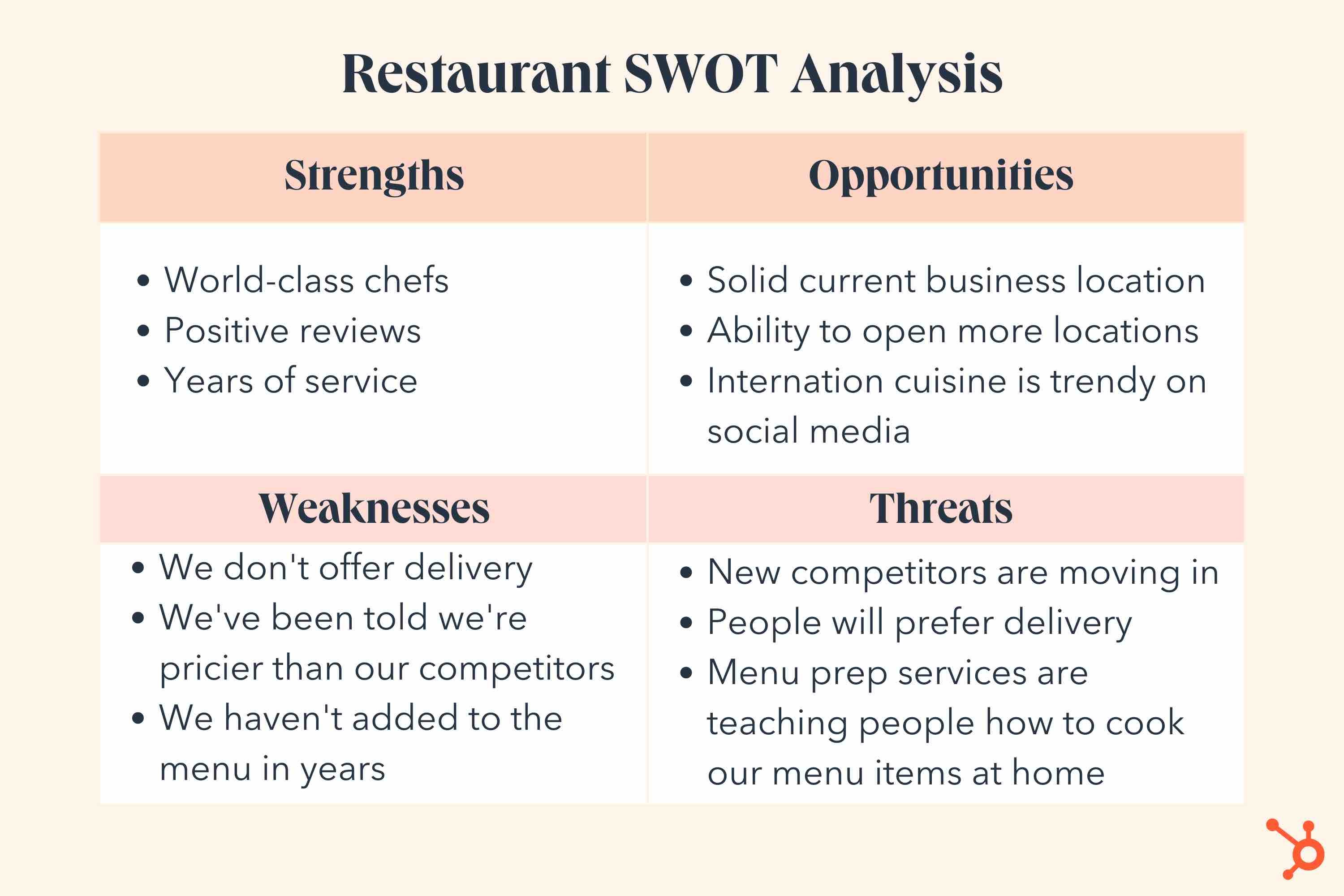
Small restaurants can lean into their culinary expertise and service skills to find opportunities for growth and brand awareness. A SWOT analysis can also help identify weaknesses that can be improved, such as menu variation and pricing.
While a restaurant might not be as worried about high-level lawsuits, a small business might be more concerned about competitors or disruptors that might enter the playing field.
Local Boutique SWOT Analysis
In another small business example, let’s take a look at a SWOT analysis for a local boutique.
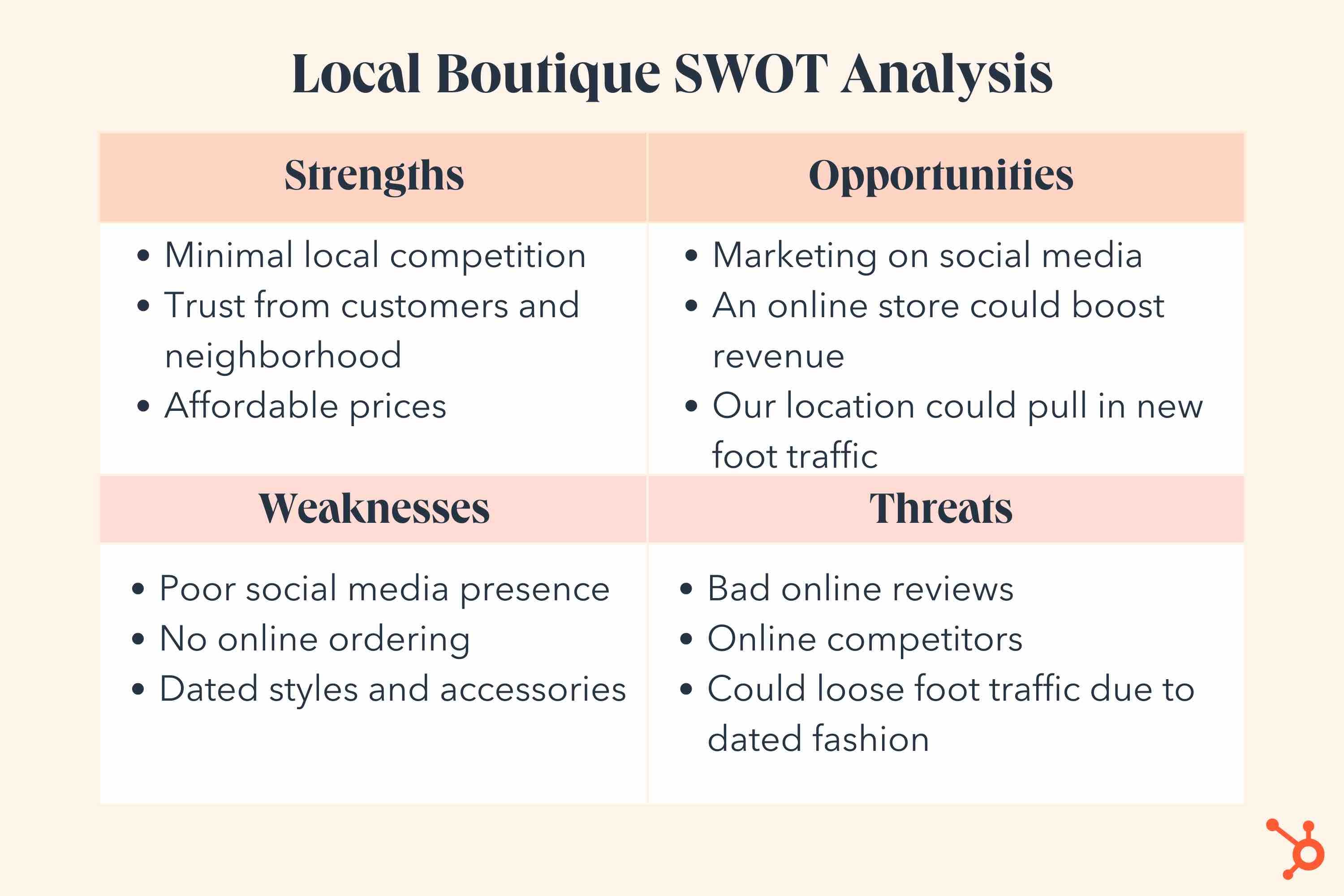
This shop might be well known in its neighborhood, but it also might take time to build an online presence or get its products in an online store.
Because of this, some of its strengths and opportunities might relate to physical factors while weaknesses and threats might relate to online situations.
How to Act on a SWOT Analysis
After conducting a SWOT analysis, you may be asking yourself: What’s next?
Putting together a SWOT analysis is only one step. Executing the findings identified by the analysis is just as important — if not more.
Put your insights into action using the following steps.
Take advantage of your strengths.
Use your strengths to pursue opportunities from your analysis.
For example, if we look at the local boutique example above, the strength of having affordable prices can be a value proposition. You can emphasize your affordable prices on social media or launch an online store.
Address your weaknesses.
Back to the boutique example, one of its weaknesses is having a poor social media presence. To mitigate this, the boutique could hire a social media consultant to improve its strategy. They may even tap into the expertise of a social-savvy employee.
Make note of the threats.
Threats are often external factors that can’t be controlled, so it’s best to monitor the threats outlined in your SWOT analysis to be aware of their impacts on your business.
When to Use a SWOT Analysis
While the examples above focus on business strategy in general, you can also use a SWOT analysis to evaluate and predict how a singular product will play out in the market.
Ultimately, a SWOT analysis can measure and tackle both big and small challenges, from deciding whether or not to launch a new product to refining your social media strategy.
Editor's note: This post was originally published in May 2018 and has been updated for comprehensiveness.

Don't forget to share this post!
Related articles.

Market Research: A How-To Guide and Template

20+ Tools & Resources for Conducting Market Research

What's a Competitive Analysis & How Do You Conduct One?

TAM SAM SOM: What Do They Mean & How Do You Calculate Them?
![swot analysis term paper How to Run a Competitor Analysis [Free Guide]](https://blog.hubspot.com/hubfs/Google%20Drive%20Integration/how%20to%20do%20a%20competitor%20analysis_122022.jpeg)
How to Run a Competitor Analysis [Free Guide]
![swot analysis term paper 5 Challenges Marketers Face in Understanding Audiences [New Data + Market Researcher Tips]](https://blog.hubspot.com/hubfs/challenges%20marketers%20face%20in%20understanding%20the%20customer%20.png)
5 Challenges Marketers Face in Understanding Audiences [New Data + Market Researcher Tips]

Causal Research: The Complete Guide

Total Addressable Market (TAM): What It Is & How You Can Calculate It

What Is Market Share & How Do You Calculate It?
![swot analysis term paper 3 Ways Data Privacy Changes Benefit Marketers [New Data]](https://blog.hubspot.com/hubfs/how-data-privacy-benefits-marketers_1.webp)
3 Ways Data Privacy Changes Benefit Marketers [New Data]
Free Guide & Templates to Help Your Market Research
Marketing software that helps you drive revenue, save time and resources, and measure and optimize your investments — all on one easy-to-use platform
We use cookies to enhance our website for you. Proceed if you agree to this policy or learn more about it.
- Essay Database >
- Essay Examples >
- Essays Topics >
- Essay on Business
SWOT Analysis Paper Examples
Type of paper: Research Paper
Topic: Business , Marketing , Apple , Market , SWOT , Food , Organization , McDonald's
Published: 04/01/2020
ORDER PAPER LIKE THIS
SWOT Analysis and its importance
SWOT analysis is a basic framework that evaluates and monitors the external and internal environment of an organization and measures its strength, weakness, opportunities and threats. In order to understand the essence of SWOT analysis, it is important that we break down its components with respect to its operating environment. External Environment: This consists of several external factors which explore the different opportunities that are available for a particular organization. Apart from this, it also evaluates the potential and current threats that might disrupt the organization’s strategic goals. - Opportunities: This is an area in which a particular company in question can earn high profitability and succeed in a longer run. If we look at the scenarios of opportunity, we find that there are three possible scenarios. The first is to offer a product or a service which is in demand but short in supply. The second is to offer its products and services in a different and a better way. The final scenario is to offer a completely new and innovative product that the market has never seen. One of the best examples of this is Apple Inc., which spotted an opportunity in the music player market and introduced its iPod. With its innovated design and user interface, iPod soon became the undisputed market leader in the music player industry. - Threats: This is a sort of a challenge that the company faces in the absence of proper marketing strategies. This may lead to loss of sales and reduction in overall profits. Although, there are always some form of minor threats in the market, the company in question cannot ignore the major ones, which have capability of hurting its market share. Internal Environment: This deals with the internal situation of the organization. What are the strengths that can be used to its advantage and what are the weaknesses that can be eliminated? - Strengths: This is probably the biggest factor that can determine the organization’s success or failure in the market. It needs to harness and take full advantage of its strength. It should be its unique selling proposition (USP). Apple Inc. makes full use of its superior brand image while marketing its expensive gadgets in the markets, and does it successfully! - Weaknesses: Every business has some weaknesses; the question is how to correct these and how to make sure that they do not affect the overall marketing efforts. Some of the weakness can be ignored, but some need to be eliminated as early as possible, or it can lead to severe long term repercussions.
SWOT Analysis for McDonald’s
Let us analyse the market situation of McDonald’s, which is the world’s biggest fast food chain in terms of revenues. Strengths: The biggest strength of McDonald’s is its powerful brand image and its presence in more than 120 different countries. This component is very important for the fast food chain’s success because by focusing and building on its strength, it can sustain its leadership in the food business. One of the best examples of its brand strength was ‘I’m lovin’ it’ campaign, which was launched in 2003 in more than 129 countries. After nearly ten years, McDonalds now has a loyal fan following. This can be concluded from the fact that if you ask any person about the origin of “I’m lovin’ it”, he or she would reply with “McDonald’s”! Opportunities: This is extremely important for the fast food giant because of it can allow McDonald’s to come out of its comfort zone and try something new. The introduction of ‘Mc Cafe’ section to all of its outlets in America can be seen as a great opportunity for the fast-food giant, as it can compete with the likes of Starbucks and target a whole new customer base. Diversification of its menu is another great opportunity through which McDonald’s can compete with Subway and grab its market share. Finally, it needs to concentrate on developing markets such as India, China and Brazil, where the number of people who consume fast food is growing at a rapid pace. Conclusion and how to use strengths and opportunities to your business advantage?

Cite this page
Share with friends using:
Removal Request

Finished papers: 1669
This paper is created by writer with
ID 281714536
If you want your paper to be:
Well-researched, fact-checked, and accurate
Original, fresh, based on current data
Eloquently written and immaculately formatted
275 words = 1 page double-spaced

Get your papers done by pros!
Other Pages
Aging essays, storax essays, batangas essays, whooping cough essays, workroom essays, sliding scale essays, derr essays, noir film the killers by robert siodmak essay examples, applied managerial accounting essay examples, research paper on starbucks, getting into china thesis, porters waiting for work in yag iskelesi istanbul 1954 photograph by ara gler term paper examples, mystery essay example, scarface movie essay examples, free research paper on inequality, epidemology research proposal sample, example of essay on comparative analysis of authors from different eras, cultural rituals and death research paper example, example of jacques lacan and jacques derrida essay, free essay on william shakespeare, argumentative essay on wwi balance of power, essay on managing information technology 4, holy child or holy terror understanding jesus anger in the infancy gospel of essay sample, breast milk and the benefits that it brings to the child and the mother essay examples, example of settlements in the west bank east jerusalem golan heights article review, adoption of a strategic plan term paper examples, example of essay on major, computer science essays example, example of list three different factors that lead to obesity that are directly stated in this article essay, tesla case studies examples, the history of the english language example research paper by an expert writer to follow, free essay about resurrection of christ, health policy and economics case study solving the medicare crisis case studies examples, a levelessay on principles of economics for free use, expertly crafted critical thinking on every customer counts, draw topic writing ideas from this essay on health care, reasons to eliminate security passwords essay template for faster writing, good essay about blood struggle, exemplar essay on health screenings and infection awareness to write after, exemplar essay on corresponding address and email to write after, proper research proposal example about sports segmentation marketing plan, perfect model essay on main post starting a thread audre lordes age race class and sex women redefining difference, systems thinking and business agility critical thinking sample.
Password recovery email has been sent to [email protected]
Use your new password to log in
You are not register!
By clicking Register, you agree to our Terms of Service and that you have read our Privacy Policy .
Now you can download documents directly to your device!
Check your email! An email with your password has already been sent to you! Now you can download documents directly to your device.
or Use the QR code to Save this Paper to Your Phone
The sample is NOT original!
Short on a deadline?
Don't waste time. Get help with 11% off using code - GETWOWED
No, thanks! I'm fine with missing my deadline
.css-s5s6ko{margin-right:42px;color:#F5F4F3;}@media (max-width: 1120px){.css-s5s6ko{margin-right:12px;}} Join us: Learn how to build a trusted AI strategy to support your company's intelligent transformation, featuring Forrester .css-1ixh9fn{display:inline-block;}@media (max-width: 480px){.css-1ixh9fn{display:block;margin-top:12px;}} .css-1uaoevr-heading-6{font-size:14px;line-height:24px;font-weight:500;-webkit-text-decoration:underline;text-decoration:underline;color:#F5F4F3;}.css-1uaoevr-heading-6:hover{color:#F5F4F3;} .css-ora5nu-heading-6{display:-webkit-box;display:-webkit-flex;display:-ms-flexbox;display:flex;-webkit-align-items:center;-webkit-box-align:center;-ms-flex-align:center;align-items:center;-webkit-box-pack:start;-ms-flex-pack:start;-webkit-justify-content:flex-start;justify-content:flex-start;color:#0D0E10;-webkit-transition:all 0.3s;transition:all 0.3s;position:relative;font-size:16px;line-height:28px;padding:0;font-size:14px;line-height:24px;font-weight:500;-webkit-text-decoration:underline;text-decoration:underline;color:#F5F4F3;}.css-ora5nu-heading-6:hover{border-bottom:0;color:#CD4848;}.css-ora5nu-heading-6:hover path{fill:#CD4848;}.css-ora5nu-heading-6:hover div{border-color:#CD4848;}.css-ora5nu-heading-6:hover div:before{border-left-color:#CD4848;}.css-ora5nu-heading-6:active{border-bottom:0;background-color:#EBE8E8;color:#0D0E10;}.css-ora5nu-heading-6:active path{fill:#0D0E10;}.css-ora5nu-heading-6:active div{border-color:#0D0E10;}.css-ora5nu-heading-6:active div:before{border-left-color:#0D0E10;}.css-ora5nu-heading-6:hover{color:#F5F4F3;} Register now .css-1k6cidy{width:11px;height:11px;margin-left:8px;}.css-1k6cidy path{fill:currentColor;}
- Project management |
SWOT analysis: Examples and templates

A SWOT analysis helps you identify strengths, weaknesses, opportunities, and threats for a specific project or your overall business plan. It’s used for strategic planning and to stay ahead of market trends. Below, we describe each part of the SWOT framework and show you how to conduct your own.
Whether you’re looking for external opportunities or internal strengths, we’ll walk you through how to perform your own SWOT analysis, with helpful examples along the way.
What is a SWOT analysis?
A SWOT analysis is a technique used to identify strengths, weaknesses, opportunities, and threats for your business or even a specific project. It’s most widely used by organizations—from small businesses and non-profits to large enterprises—but a SWOT analysis can be used for personal purposes as well.
While simple, a SWOT analysis is a powerful tool for helping you identify competitive opportunities for improvement. It helps you improve your team and business while staying ahead of market trends.
What does SWOT stand for?
SWOT is an acronym that stands for:
Opportunities

When analyzed together, the SWOT framework can paint a larger picture of where you are and how to get to the next step. Let’s dive a little deeper into each of these terms and how they can help identify areas of improvement.
Strengths in SWOT refer to internal initiatives that are performing well. Examining these areas helps you understand what’s already working. You can then use the techniques that you know work—your strengths—in other areas that might need additional support, like improving your team’s efficiency .
When looking into the strengths of your organization, ask yourself the following questions:
What do we do well? Or, even better: What do we do best?
What’s unique about our organization?
What does our target audience like about our organization?
Which categories or features beat out our competitors?
Example SWOT strength:
Customer service: Our world-class customer service has an NPS score of 90 as compared to our competitors, who average an NPS score of 70.
Weaknesses in SWOT refer to internal initiatives that are underperforming. It’s a good idea to analyze your strengths before your weaknesses in order to create a baseline for success and failure. Identifying internal weaknesses provides a starting point for improving those projects.
Identify the company’s weaknesses by asking:
Which initiatives are underperforming and why?
What can be improved?
What resources could improve our performance?
How do we rank against our competitors?
Example SWOT weakness:
E-commerce visibility: Our website visibility is low because of a lack of marketing budget , leading to a decrease in mobile app transactions.
Opportunities in SWOT result from your existing strengths and weaknesses, along with any external initiatives that will put you in a stronger competitive position. These could be anything from weaknesses that you’d like to improve or areas that weren’t identified in the first two phases of your analysis.
Since there are multiple ways to come up with opportunities, it’s helpful to consider these questions before getting started:
What resources can we use to improve weaknesses?
Are there market gaps in our services?
What are our business goals for the year?
What do your competitors offer?
Example SWOT opportunities:
Marketing campaign: To improve brand visibility, we’ll run ad campaigns on YouTube, Facebook, and Instagram.
Threats in SWOT are areas with the potential to cause problems. Different from weaknesses, threats are external and out of your control. This can include anything from a global pandemic to a change in the competitive landscape.
Here are a few questions to ask yourself to identify external threats:
What changes in the industry are cause for concern?
What new market trends are on the horizon?
Where are our competitors outperforming us?
Example SWOT threats:
New competitor: With a new e-commerce competitor set to launch within the next month, we could see a decline in customers.
SWOT analysis example
One of the most popular ways to create a SWOT analysis is through a SWOT matrix—a visual representation of strengths, weaknesses, opportunities, and threats. The matrix comprises four separate squares that create one larger square.
A SWOT matrix is great for collecting information and documenting the questions and decision-making process . Not only will it be handy to reference later on, but it’s also great for visualizing any patterns that arise.
Check out the SWOT matrix below for a simple example. As you can see, each of the quadrants lists out the company's strengths, weaknesses, opportunities, and threats.
![swot analysis term paper [Inline illustration] SWOT analysis (Example)](https://assets.asana.biz/transform/cfab4ed2-46d1-4636-b801-14b3d86c8367/inline-project-management-SWOT-analysis-4-2x?io=transform:fill,width:2560&format=webp)
When used correctly and effectively, your matrix can be a great toolkit for evaluating your organization’s strengths and weaknesses.
How to do a SWOT analysis, with examples
A SWOT analysis can be conducted in a variety of ways. Some teams like to meet and throw ideas on a whiteboard, while others prefer the structure of a SWOT matrix. However you choose to make your SWOT analysis, getting creative with your planning process allows new ideas to flow and results in more unique solutions.
There are a few ways to ensure that your SWOT analysis is thorough and done correctly. Let’s take a closer look at some tips to help you get started.
Tip 1: Consider internal factors
Often, strengths and weaknesses stem from internal processes. These tend to be easier to solve since you have more control over the outcome. When you come across internal factors, you can start implementing improvements in a couple of different ways.
Meet with department stakeholders to form a business plan around how to improve your current situation.
Research and implement new tools, such as a project management tool , that can help streamline these processes for you.
Take immediate action on anything that can be changed in 24 hours or less. If you don’t have the capacity, consider delegating these items to others with deadlines.
The way you go about solving internal factors will depend on the type of problem. If it’s more complex, you might need to use a combination of the above or a more thorough problem management process.
Tip 2: Evaluate external factors
External factors stem from processes outside of your control. This includes competitors, market trends, and anything else that’s affecting your organization from the outside in.
External factors are trickier to solve, as you can’t directly control the outcome. What you can do is pivot your own processes in a way that mitigates negative external factors.
You can work to solve these issues by:
Competing with market trends
Forecasting market trends before they happen
Improving adaptability to improve your reaction time
Track competitors using reporting tools that automatically update you as soon as changes occur
While you won’t be able to control an external environment, you can control how your organization reacts to it.
Let’s say, for instance, that you’re looking to compete with a market trend. For example, a competitor introduced a new product to the market that’s outperforming your own. While you can’t take that product away, you can work to launch an even better product or marketing campaign to mitigate any decline in sales.
Tip 3: Hold a brainstorming session
Brainstorming new and innovative ideas can help to spur creativity and inspire action. To host a high impact brainstorming session, you’ll want to:
Invite team members from various departments. That way, ideas from each part of the company are represented.
Be intentional about the number of team members you invite, since too many participants could lead to a lack of focus or participation. The sweet spot for a productive brainstorming session is around 10 teammates.
Use different brainstorming techniques that appeal to different work types.
Set a clear intention for the session.
Tip 4: Get creative
In order to generate creative ideas, you have to first invite them. That means creating fun ways to come up with opportunities. Try randomly selecting anonymous ideas, talking through obviously bad examples, or playing team building games to psych up the team.
Tip 5: Prioritize opportunities
Now, rank the opportunities. This can be done as a team or with a smaller group of leaders. Talk through each idea and rank it on a scale of one through 10. Once you’ve agreed on your top ideas based on team capabilities, competencies, and overall impact, it’s easier to implement them.
Tip 6: Take action
It’s all too easy to feel finished at this stage —but the actual work is just beginning. After your SWOT analysis, you’ll have a list of prioritized opportunities. Now is the time to turn them into strengths. Use a structured system such as a business case , project plan, or implementation plan to outline what needs to get done—and how you plan to do it.
SWOT analysis template
A SWOT analysis template is often presented in a grid format, divided into four quadrants. Each quadrant represents one of the four elements.
Use this free SWOT analysis template to jump-start your team’s strategic planning.
Identify the strengths that contribute to achieving your objectives. These are internal characteristics that give you an advantage. Some examples could be a strong brand reputation, an innovative culture, or an experienced management team.
Next, focus on weaknesses. These are internal factors that could serve as obstacles to achieving your objectives. Common examples might include a lack of financial resources, high operational costs, or outdated technology.
Move on to the opportunities. These are external conditions that could be helpful in achieving your goals. For example, you might be looking at emerging markets, increased demand, or favorable shifts in regulations.
Lastly, let's address threats. These are external conditions that could negatively impact your objectives. Examples include increased competition or potential economic downturns.
Why is a SWOT analysis important?
A SWOT analysis can help you improve processes and plan for growth. While similar to a competitive analysis , it differs because it evaluates both internal and external factors. Analyzing key areas around these opportunities and threats will equip you with the insights needed to set your team up for success.

A SWOT analysis isn’t only useful for organizations. With a personal SWOT analysis, you can examine areas of your life that could benefit from improvement, from your leadership style to your communication skills. These are the benefits of using a SWOT analysis in any scenario.
1. Identifies areas of opportunity
One of the biggest benefits of conducting an analysis is to determine opportunities for growth. It’s a great starting point for startups and teams that know they want to improve but aren’t exactly sure how to get started.
Opportunities can come from many different avenues, like external factors such as diversifying your products for competitive advantage or internal factors like improving your team’s workflow . Either way, capitalizing on opportunities is an excellent way to grow as a team.
2. Identifies areas that could be improved
Identifying weaknesses and threats during a SWOT analysis can pave the way for a better business strategy.
Ultimately, learning from your mistakes is the best way to excel. Once you find areas to streamline, you can work with team members to brainstorm an action plan . This will let you use what you already know works and build on your company’s strengths.
3. Identifies areas that could be at risk
Whether you have a risk register in place or not, it’s always crucial to identify risks before they become a cause for concern. A SWOT analysis can help you stay on top of actionable items that may play a part in your risk decision-making process.
It may be beneficial to pair your SWOT analysis with a PEST analysis, which examines external solutions such as political, economic, social, and technological factors—all of which can help you identify and plan for project risks .
When should you use a SWOT analysis?
You won’t always need an in-depth SWOT analysis. It’s most useful for large, general overviews of situations, scenarios, or your business.
A SWOT analysis is most helpful:
Before you implement a large change—including as part of a larger change management plan
When you launch a new company initiative
If you’d like to identify opportunities for growth and improvement
Any time you want a full overview of your business performance
If you need to identify business performance from different perspectives
SWOT analyses are general for a reason—so they can be applied to almost any scenario, project, or business.
SWOT analysis: Pros and cons
Although SWOT is a useful strategic planning tool for businesses and individuals alike, it does have limitations. Here’s what you can expect.
The simplicity of SWOT analysis makes it a go-to tool for many. Because it is simple, it takes the mystery out of strategic planning and lets people think critically about their situations without feeling overwhelmed.
For instance, a small bakery looking to expand its operations can use SWOT analysis to easily understand its current standing. Identifying strengths like a loyal customer base, weaknesses such as limited seating space, opportunities like a rising trend in artisanal baked goods, and threats from larger chain bakeries nearby can all be accomplished without any specialized knowledge or technical expertise.
Versatility
Its versatile nature allows SWOT analysis to be used across various domains. Whether it’s a business strategizing for the future or an individual planning their career path, SWOT analysis lends itself well.
For example, a tech start-up in the competitive Silicon Valley landscape could employ SWOT to navigate its pathway to profitability. Strengths might include a highly skilled development team; weaknesses could be a lack of brand recognition; opportunities might lie in emerging markets; and threats could include established tech giants.
Meaningful analysis
SWOT excels in identifying external factors that could impact performance. It nudges organizations to look beyond the present and anticipate potential future scenarios.
A retail company, for example, could use SWOT analysis to identify opportunities in e-commerce and threats from changing consumer behavior or new competitors entering the market. By doing so, the company can strategize on how to leverage online platforms to boost sales and counteract threats by enhancing the customer experience or adopting new technologies.
Subjectivity and bias
The subjective nature of SWOT analysis may lead to biases. It relies heavily on individual perceptions, which can sometimes overlook crucial data or misinterpret information, leading to skewed conclusions.
For example, a manufacturing company might undervalue the threat of new entrants in the market due to an overconfidence bias among the management. This subjectivity might lead to a lack of preparation for competitive pricing strategies, ultimately affecting the company's market share.
Lack of prioritization
SWOT analysis lays out issues but falls short on prioritizing them. Organizations might struggle to identify which elements deserve immediate attention and resources.
For instance, a healthcare provider identifying numerous opportunities for expansion into new services may become overwhelmed with the choices. Without a clear way to rank these opportunities, resources could be spread too thinly or given to projects that do not have as much of an impact, leading to less-than-ideal outcomes.
Static analysis
Since SWOT analysis captures a snapshot at a particular moment, it may miss the evolving nature of challenges and opportunities, possibly leading to outdated strategies. An example could be a traditional retail business that performs a SWOT analysis and decides to focus on expanding physical stores, overlooking the growing trend of e-commerce. As online shopping continues to evolve and gain popularity, the static analysis might lead to investment in areas with diminishing returns while missing out on the booming e-commerce market trend.
SWOT analysis FAQ
What are the five elements of swot analysis.
Traditionally, SWOT stands for its four main elements: strengths, weaknesses, opportunities, and threats. However, a fifth essential element often overlooked is "actionable strategies." Originally developed by Albert Humphrey, SWOT is more than just a list—it's a planning tool designed to generate actionable strategies for making informed business decisions. This fifth element serves to tie the other four together, enabling departments like human resources and marketing to turn analysis into actionable plans.
What should a SWOT analysis include?
A comprehensive SWOT analysis should focus on the internal and external factors that affect your organization. Internally, consider your strong brand and product line as your strengths, and maybe your supply chain weaknesses. Externally, you'll want to look at market share, partnerships, and new technologies that could either pose opportunities or threats. You should also account for demographics, as it helps in market targeting and segmentation.
How do you write a good SWOT analysis?
Writing an effective SWOT analysis begins with research. Start by identifying your strengths, like a strong brand, and your weaknesses, like a small human resources department. Following that, look outward to find opportunities, possibly in technological advancement, and threats, like fluctuations in market share. Many businesses find it helpful to use a free SWOT analysis template to structure this information. A good SWOT analysis doesn't just list these elements; it integrates them to provide a clear roadmap for making business decisions.
What are four examples of threats in SWOT analysis?
New technologies: Rapid technological advancement can make your product or service obsolete.
Supply chain disruptions: Whether due to natural disasters or geopolitical tensions, an unstable supply chain can seriously jeopardize your operations.
Emerging competitors: New players entering the market can erode your market share and offer alternative solutions to your customer base.
Regulatory changes: New laws or regulations can add costs and complexity to your business, affecting your competitiveness.
How do you use a SWOT analysis?
Once you've completed a SWOT analysis, use the results as a decision-making aid. It can help prioritize actions, develop strategic plans that play to your strengths, improve weaknesses, seize opportunities, and counteract threats. It’s a useful tool for setting objectives and creating a roadmap for achieving them.
Plan for growth with a SWOT analysis
A SWOT analysis can be an effective technique for identifying key strengths, weaknesses, opportunities, and threats. Understanding where you are now can be the most impactful way to determine where you want to go next.
Don’t forget, a bit of creativity and collaboration can go a long way. Encourage your team to think outside of the box with 100+ team motivational quotes .
Related resources

Critical path method: How to use CPM for project management

15 project management interview questions, answers, and tips

Unmanaged business goals don’t work. Here’s what does.

How Asana uses work management to drive product development

- Guide on Writing a Stellar Essay
- Tips on Writing an Effective Term Paper
SWOT Analysis Term Paper
Swot analysis term paper:.
SWOT analysis is the method of the strategic planning, which studies the influence of the internal and outer factors on the work on an organization. The acronym SWOT is deciphered easily and means Strengths, Weaknesses, Opportunities and Threats. The first two indicators (strengths and weaknesses) are regarded as the internal factors and the opportunities and threats are believed to be the outer factors which influence the functioning of an organization. SWOT analysis is very important for business, because if the executives of the company decide to improve the quality and the quantity of their production and increase profit, they will have to analyze the strong and the weak sides in the work of the organization and pay attention to the both factors. For example, if the company has certain weak sides, a detailed analysis and a range of innovations and improvements can normalize the situation easily.
We can write a Custom SWOT Analysis Term Paper for you!
On the contrary, such factors as the opportunity and threat can not be controlled, because one can only predict the possible challenges waiting for the company, for example, if the popularity of the production reduces (the interest of the consumers suddenly disappears), the company will not be able to influence the customers, but simply follow their requirements and produce something else to survive on the market. The beginning of the first attempts to conduct SWOT analysis was in the 1960-ies and very often the method became widespread and even became the part of the educational process. The main task of SWOT analysis is to describe the situation in the company in detail on the basis of which the executives are supposed to draw the right conclusions and brainstorm the right solutions, because the strategy is not aimed to recommend something, but simply has the informative and descriptive function.
SWOT analysis id the basis strategy which is supposed to organize the work of the company well. A good term paper on SWOT analysis should contain up-to-date information about the analysis, its types, methods and purposes. One should evaluate the relevance of the topic and define its importance for business. The student is expected to illustrate the effectiveness of SWOT analysis on the definite examples from the real life and share the methodology and literature sources used for the research of the chosen problem.
The core requirement of every professor concerning the process of term paper writing is the original content and the right structure of the paper, so one can use a free SWOT analysis term paper sample in the Internet and learn about the process of writing a lot. With the help of a free SWOT analysis term paper example it is easy to catch the ways of formatting, composition of the text and the right analysis of the topic.

Related Posts:
- Southwest Airlines Term Paper
- Pro Forma Income Statement Term Paper
- Financial Analysis Essay Sample
- Design of Experiment Term Paper
- Reflective Essay Sample
Leave a Reply Cancel Reply
Current ye@r *
Leave this field empty
Below you have a great opportunity to hire a professional term paper writer for getting custom writing help now:

- Term papers
- Uncategorized
Academia.edu no longer supports Internet Explorer.
To browse Academia.edu and the wider internet faster and more securely, please take a few seconds to upgrade your browser .
Enter the email address you signed up with and we'll email you a reset link.
- We're Hiring!
- Help Center

ANALISIS SWOT MANAJEMEN STRATEGI PADA ASURANSI SYARIAH DI PT. ASURANSI JMA SYARIAH

2023, Artikel
This research aims to determine strategic management at PT. Asuransi JMA Syariah. Based on the problems studied, the data analysis method used in this research is descriptive with a qualitative approach. The method used is to analyze the internal (strengths and weaknesses) and external (opportunities and threats) environment. SWOT analysis is carried out through the IFE (Internal Factor Evaluation) matrix, EFE (External Factor Evaluation) and IE (Internal External) matrix. The type of data used in this research is qualitative data. The qualitative data in this research is in the form of secondary data, namely that obtained from the data sources used which can include reading related literature, for example internet sites and scientific journals. The results of the research conducted show that the company is strong and has the opportunity to use the Strength and Opportunities (SO) strategy, namely using its strengths to take advantage of existing opportunities and anticipate future threats.
Related Papers
garaudi al mujahid
Abstrak SWOT stands for Strengths, Weaknesses, Opportunities and Threats facing the business world. The SWOT analysis compares the external factors of Opportunities and Threats and internal factors Strengths and Weaknesses. The SWOT analysis is an assessment of current conditions and the foresight that affect the process of achieving the goals of the institution. With SWOT analysis will be obtained characteristics of strengths and weaknesses based on analysis of internal and external environment. Sharia insurance has started to be known in Indonesia since the establishment of Syarikat Takaful in 1994, in 2015 estimated that the potential of sharia premium revenue in Indonesia will reach US $ 1.20 billion. The results of SWOT analysis on sharia insurance will illustrate some of the causes of the relatively low penetration of the Takaful market in the last twenty years such as the low funds that shore up the sharia insurance company, the promotion and education of the market has not been done effectively yet, sharia, products and services have not been favored on conventional products, market position is still in doubt between the implementation of the concept of sharia thoroughly with the reality of business in the field, reinsurance capacity support is still limited and the absence of product innovation and services are really excavated from the basic concept of sharia.
Ninda Imalda
Arni Tsalitsa
Yuni Puspita Sari
Management strategy is a series of decisions and managerial actions that determine the company's performance in the long term by managing the company through management strategy in a tactical plan that is chosen to be implemented and implemented so that the company excels in the business world. The aim of the research is to analyze both internal and external management strategies implemented by PT. Adira Finance at this time. This research method uses descriptive analysis with SWOT analysis. The research results show that the management strategy implemented by PT. Adira Finance is right.
Alfu Lailah
evi komalasari
Strategi Manajemen Sumber Daya Manusia dan Kinerja Organisasi di Sektor Manufaktur Nigeria: Sebuah Investigasi Empiris
cleber pereira
Natália Almeida Ramos
RELATED PAPERS
ulul azmi muaffa
Journal of Ocean Engineering and Marine Energy
Lars Johanning
Journal of Social and Clinical Psychology
Eva Gilboa-schechtman
Journal of Family Therapy
Kerreen Reiger
Jacob Juncker
Victor Tremblay-Baillargeon
Jelena Vlašić Duić
Greener Journal of Science, Engineering and Technological Research
Olalekan Jesuleye
Gazebo Bambu Murah Semarang
Jual Rumah Joglo Di Jogja
Universitat de Barcelona. Institut de Ciències de l’Educació
Mariola Puig
Hamiyet Yüce
American journal of human genetics
Melissa Lees
Tero Laihinen
Asian Review of Financial Research
Hee-Joon Ahn
ASCILITE Publications
Jason Zagami
Dalton Trans.
Guoxin tian
European Journal of Engineering Research and Science
ADEKUNLE YEKINNI
Eletrônica de Potência
Marcelo Godoy Simoes
Applied Ergonomics
Robert Radwin
71th Annual Meeting of the APS Division of Fluid Dynamics - Gallery of Fluid Motion
Guillermo Araya
Open Journal of Psychiatry
fatma baklouti
Proceedings of the 3rd Asian Education Symposium (AES 2018)
Fitriana Prihati
See More Documents Like This
RELATED TOPICS
- We're Hiring!
- Help Center
- Find new research papers in:
- Health Sciences
- Earth Sciences
- Cognitive Science
- Mathematics
- Computer Science
- Academia ©2024

IMAGES
VIDEO
COMMENTS
SWOT analysis is a strategic planning and management technique proposed by American management scientist Albert Humphrey in the early 1960s (Hill & Westbrook, 1997). The term SWOT represents four ...
The SOFT approach is the progenitor of SWOT analysis in all its variations. ... Note the order in which long-term corporate plans have to be created in Stewart's frame; A firm must first articulate its current operational planning issues. ... we show in this paper how to use SWOT in the future and highlight its participatory managerial nature ...
Successful businesses and people have been conducting SWOTs since at least the mid-twentieth century and have refined the process over time. The four categories you will explore in your SWOT analysis paper are Strengths (S), Weaknesses (W), Opportunities (O), and Threats (T). You can use SWOT analysis to help you assess your position in project planning, business development, finance ...
An Example of a Personal SWOT Analysis . An Example of a Business SWOT Analysis . Final Words. The humble but effective SWOT analysis will produce a detailed map of your current environment—its hills and valleys alike. Knowing how to write a SWOT analysis will provide you with the vantage point you need to choose a direction and blaze a trail ...
Panagiotou, 2003). After the 1960s, the SWOT analysis was used by numerous researchers and scholars of strategic planning. In the 1980s, the SWOT analysis was extensively reintroduced (Hadighi & Mahdavi, 2011; Wernerfelt, 1984). Hoskisson et al. (1999) stated that SWOT had become a dominant framework in the field of strategic management in the ...
The term SWOT Analysis is made up of four elements: ️ Strengths; ️ Weaknesses; ️ Opportunities; ️ Threats; Strengths. Strengths describe what works well for a company. It can be a strong brand, a loyal customer base, an effective marketing strategy, and so on. ... SWOT Analysis Essay Format. Writing a SWOT Analysis paper can be scary ...
SWOT Analysis (short for strengths, weaknesses, opportunities, threats) is a business strategy tool to assess how an organization compares to its competition. The strategy is historically credited to Albert Humphrey in the 1960s, but this attribution remains debatable. There is no universally-accepted creator. Also known as the SWOT Matrix, it has achieved recognition as useful in ...
A SWOT analysis is a high-level strategic planning model that helps organizations identify where they're doing well and where they can improve, both from an internal and an external perspective. SWOT is an acronym for "Strengths, Weaknesses, Opportunities, and Threats.". . SWOT works because it helps you evaluate your business by ...
First, the analysis paper should be broken down into three parts that will help you out, and they are as follows: The company itself; The analysis; The strategies to convert weaknesses to strengths; The ability to handle opportunities and neutralizing threats; Any other growth strategies. This is what the paper should be about, and by having ...
3. Pinpoint Your or Your Organization's Strengths. Now, it's time for the brainstorming session. If you're doing a SWOT analysis for a business, go with it: bring the right people to the table, virtual or not. It'll help you get a more objective, realistic, and complete matrix.
How to do SWOT Analysis. You can conduct a SWOT analysis with the following four steps: Step 1: Selecting a company. If your assignment requires conducting a SWOT analysis, you are either given a case study company by your educational institution or you are free to analyze a company of your own choice.
SWOT analysis is a process that identifies an organization's strengths, weaknesses, opportunities and threats. Specifically, SWOT is a basic, analytical framework that assesses what an entity ...
A SWOT analysis can help guide you to better-informed conclusions that are more likely to produce long-term benefits. Invented by Albert Humphrey at the Stanford Research Institute in the 1960s, the SWOT analysis framework has been adopted by businesses and individual decision-makers worldwide.
A SWOT analysis is a framework used in a business's strategic planning to evaluate its competitive positioning in the marketplace. The analysis looks at four key characteristics that are ...
If you're considering a brand redesign, you'll want to consider existing and future brand conceptions. All of these are examples of good reasons to conduct a SWOT analysis. By identifying your objective, you'll be able to tailor your evaluation to get more actionable insights. 4. Identify your strengths.
Term Paper 515 - Free download as Word Doc (.doc), PDF File (.pdf), Text File (.txt) or read online for free. SWOT analysis is a Strategic Planning method used to evaluate the strengths, weaknesses, opportunities, and threats involved in a project or in a business venture. It involves specifying the objective of the business venture or project and identifying the internal and external factors ...
SWOT Analysis for McDonald's. Let us analyse the market situation of McDonald's, which is the world's biggest fast food chain in terms of revenues. Strengths: The biggest strength of McDonald's is its powerful brand image and its presence in more than 120 different countries. This component is very important for the fast food chain's ...
Key Highlights. SWOT is used to help assess the internal and external factors that contribute to a company's relative advantages and disadvantages. A SWOT analysis is generally used in conjunction with other assessment frameworks, like PESTEL and Porter's 5-Forces. Findings from a SWOT analysis will help inform model assumptions for the ...
SWOT analysis: Examples and templates. Alicia Raeburn. February 24th, 2024 11 min read. Summary. A SWOT analysis helps you identify strengths, weaknesses, opportunities, and threats for a specific project or your overall business plan. It's used for strategic planning and to stay ahead of market trends.
According to Jones and George (2008:308), the SWOT analysis is "A planning exercise in which managers identify organizational strengths (s) and weaknesses (W) and environmental opportunities (O) and threats (T)". Strengths might include adequate financial resources, economies of scale, and proprietary technology.
The SWOT analysis determines the strength, weakness, opportunities and threats of APEX. The SWOT analysis are given below- Strength Market Leader: APEX is one of the market leader of shoes in Bangladesh. Apex is continuously delivering high quality product through their sophisticated technology that causes minimum harm to the nature.
Your sample SWOT Analysis term paper. Free example of term paper onSWOT Analysis topics and ideas. Guidelines how to write good academic papers and essays online. 15 49.0138 8.38624 1 0 4000 1 https://yourtermpapers.com 300 0. About Us; Guide on Writing a Stellar Essay; Tips on Writing an Effective Term Paper; SWOT Analysis Term Paper.
Term Paper_Strategic Management - Free download as PDF File (.pdf), Text File (.txt) or read online for free.
With SWOT analysis will be obtained characteristics of strengths and weaknesses based on analysis of internal and external environment. Sharia insurance has started to be known in Indonesia since the establishment of Syarikat Takaful in 1994, in 2015 estimated that the potential of sharia premium revenue in Indonesia will reach US $ 1.20 billion.
Analysis of Key Strategies & Plans for the Medium Term Horizon; Detailed Comparative SWOT Analysis for the A&D OEMs; ... Section 3: SWOT Analysis-For each of the Top 7 Industry Players.